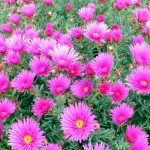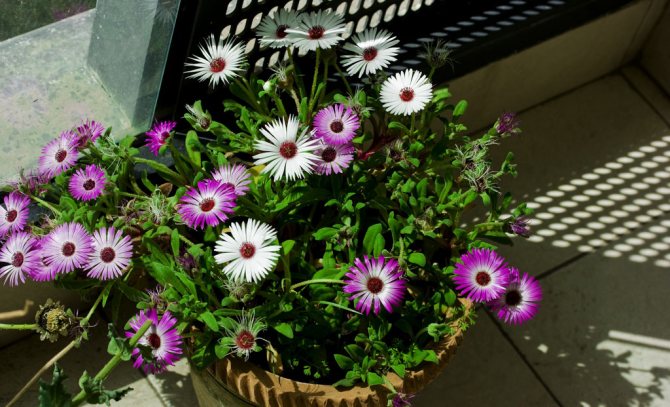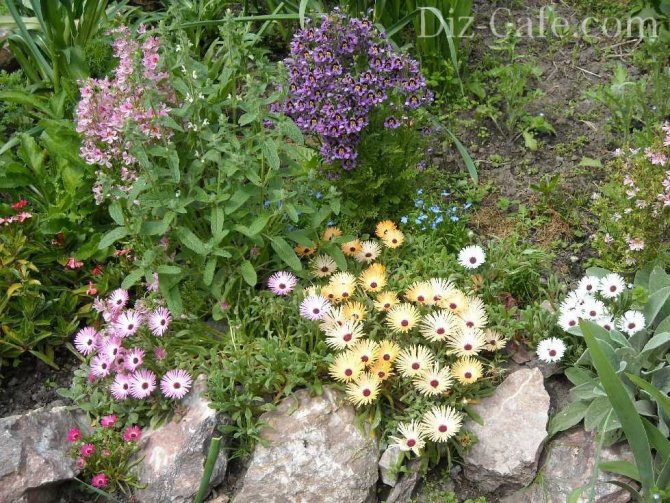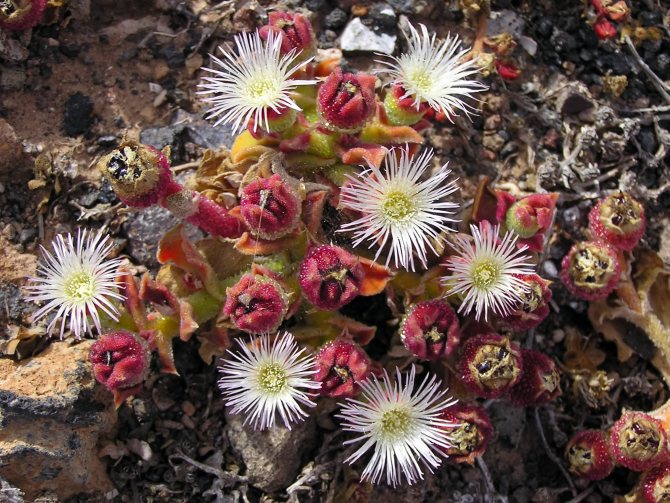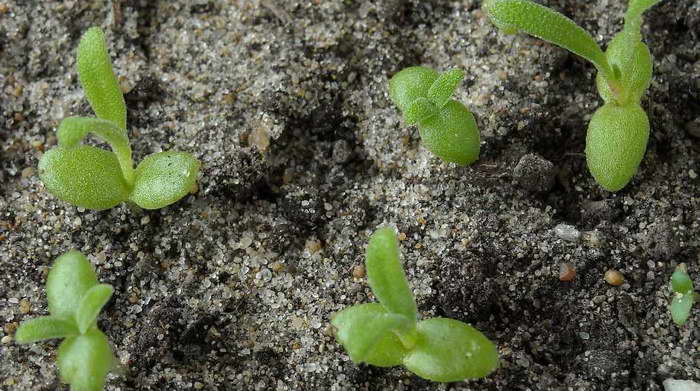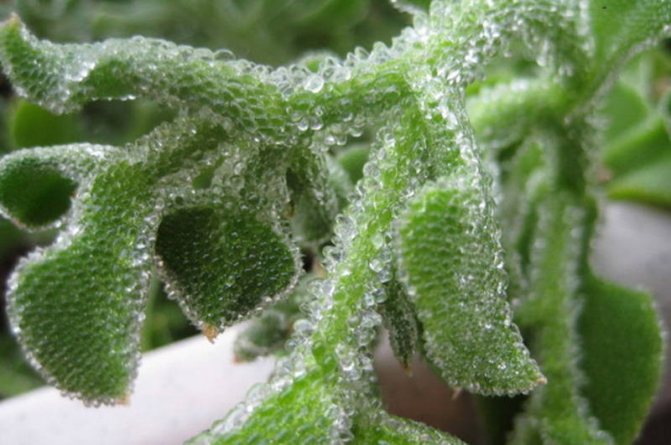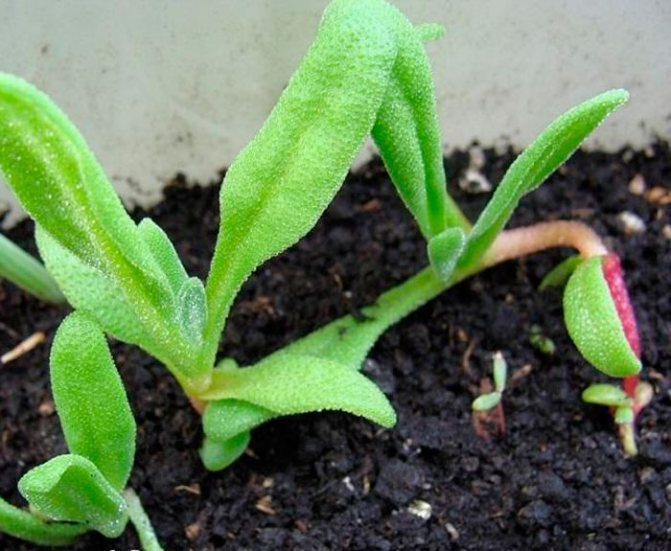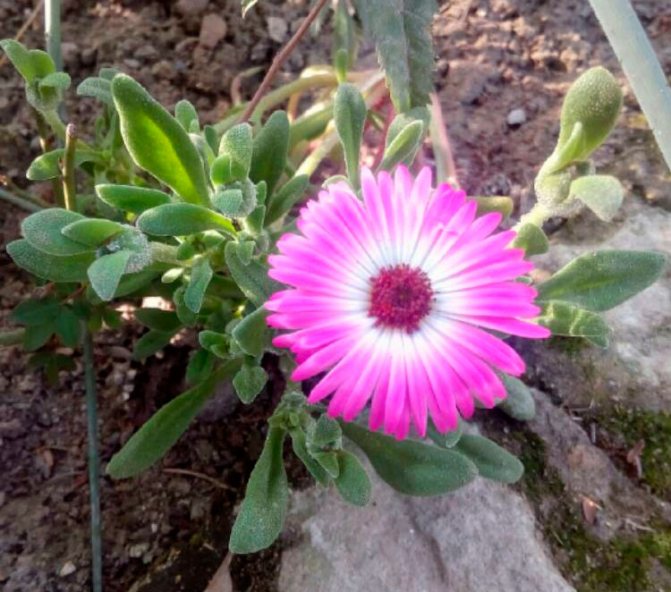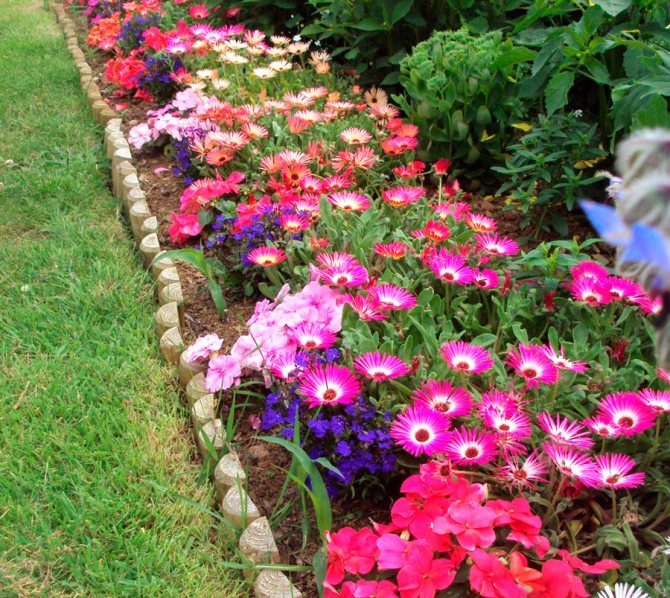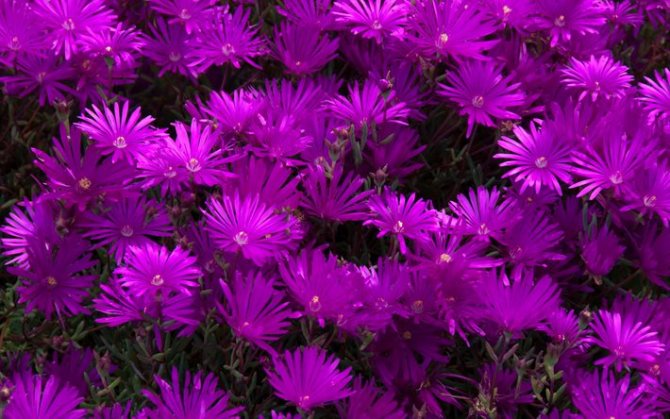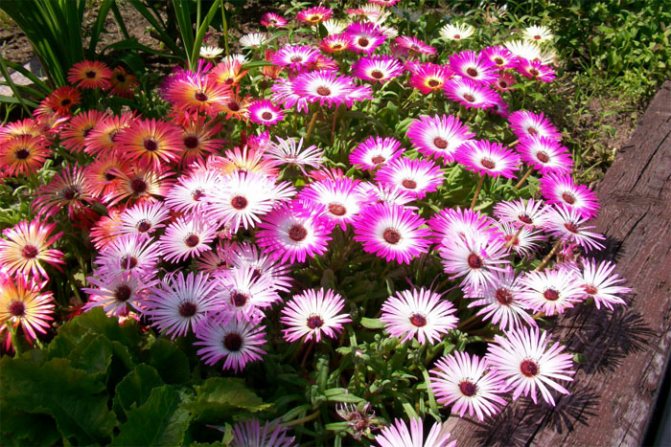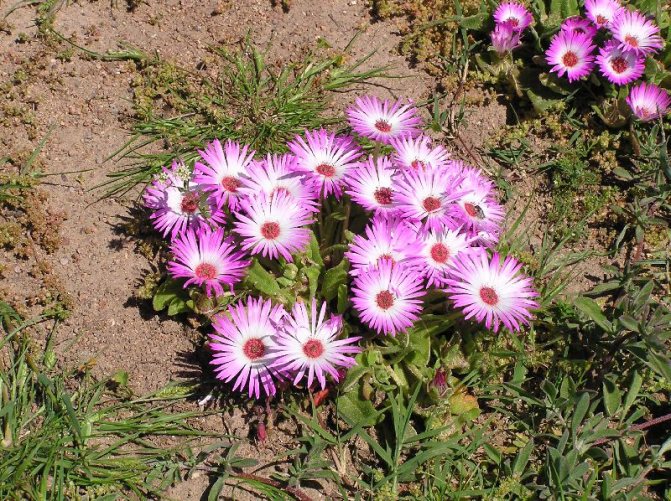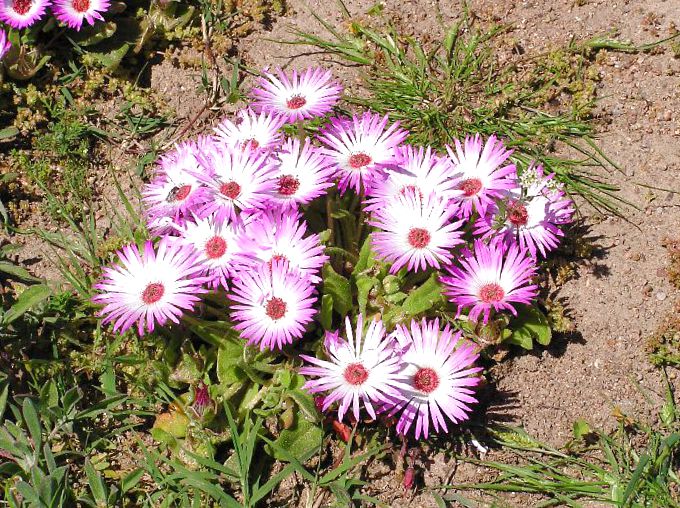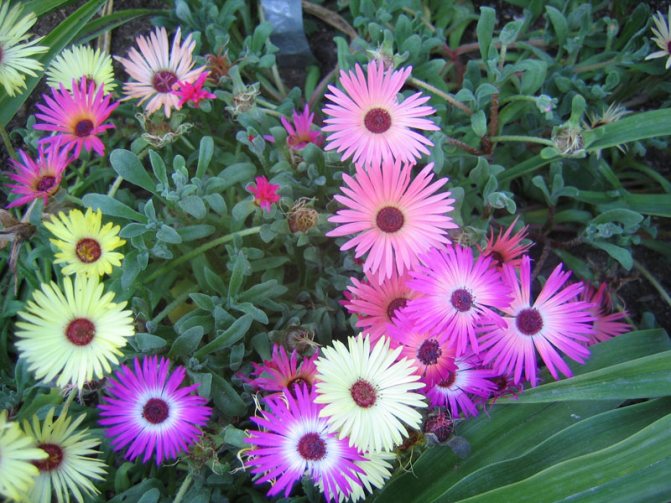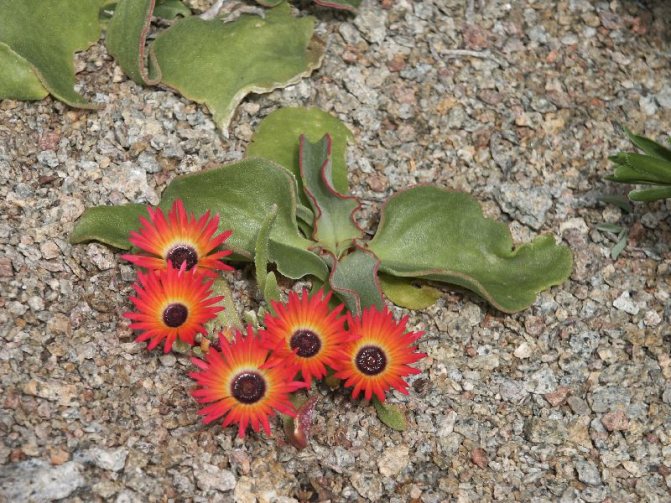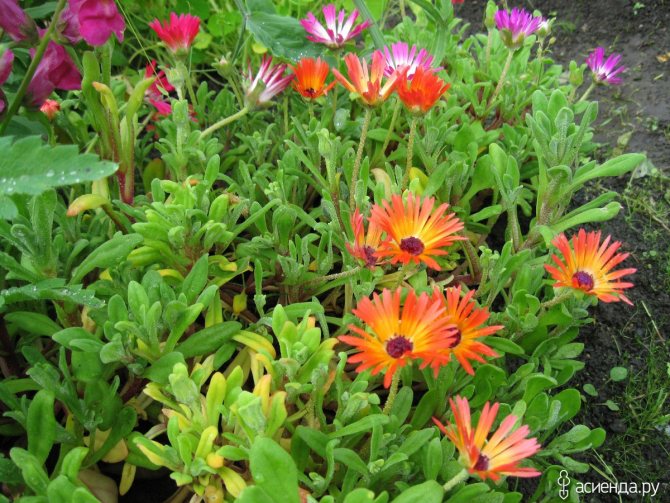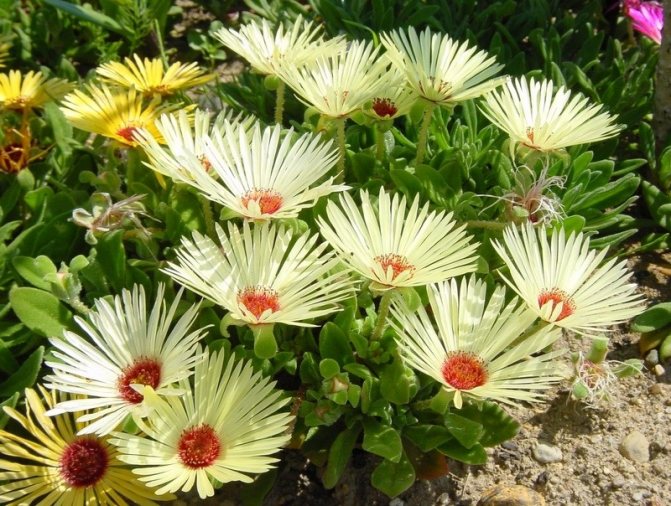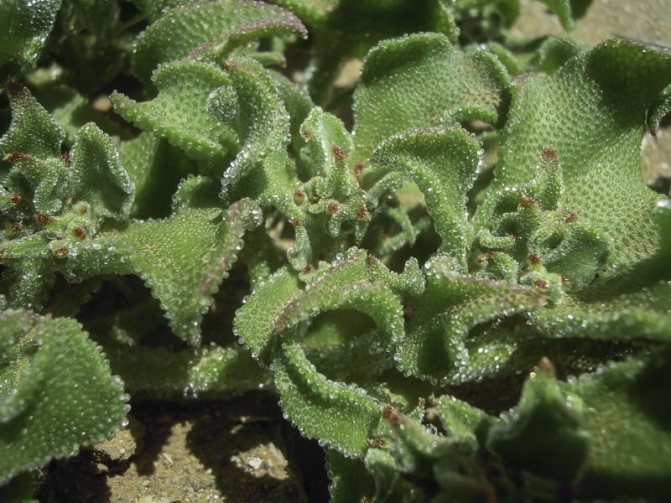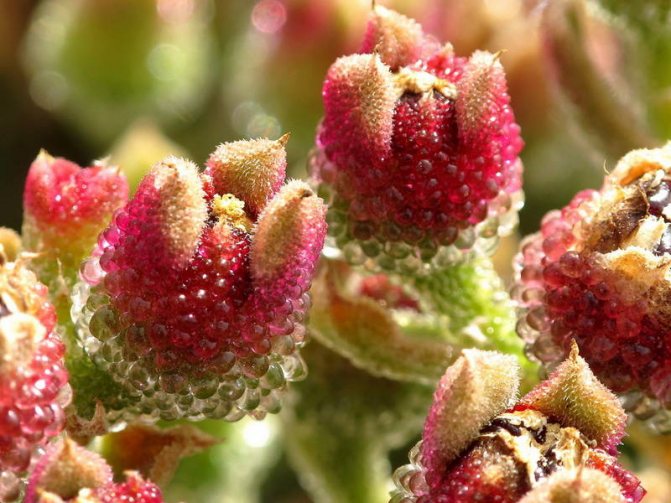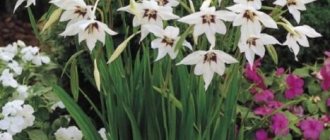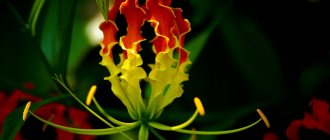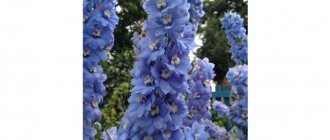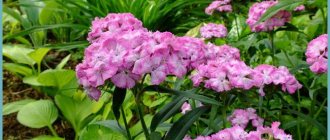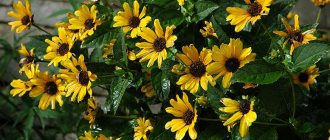Mesembryanthemum is a succulent annual or biennial plant that is a member of the Azizaceae family. In nature, it is found in South Africa. This plant was named a mesembriantemum in 1684, from Greek this name is translated as "midday flower", because the mesembriantemums known at that time united such a feature as the opening of flowers only in sunny weather. This plant is also called "midday" or "sunflower". But in 1719, species were found that bloom only at night. According to various sources, this genus unites from 50 to 80 species.
Mesembriantemum: growing from seeds, planting and care in the open field
Mesembryanthemum is a succulent annual or biennial plant that is a member of the Azizaceae family. In nature, it is found in South Africa. This plant was named a mesembriantemum in 1684, from Greek this name is translated as "midday flower", because the mesembriantemums known at that time united such a feature as the opening of flowers only in sunny weather. This plant is also called "midday" or "sunflower". But in 1719, species were found that bloom only at night. According to various sources, this genus unites from 50 to 80 species.
Gallery: Mesembriantemum, or Dorotheanthus (25 photos)
Features of the mesembryanthemum
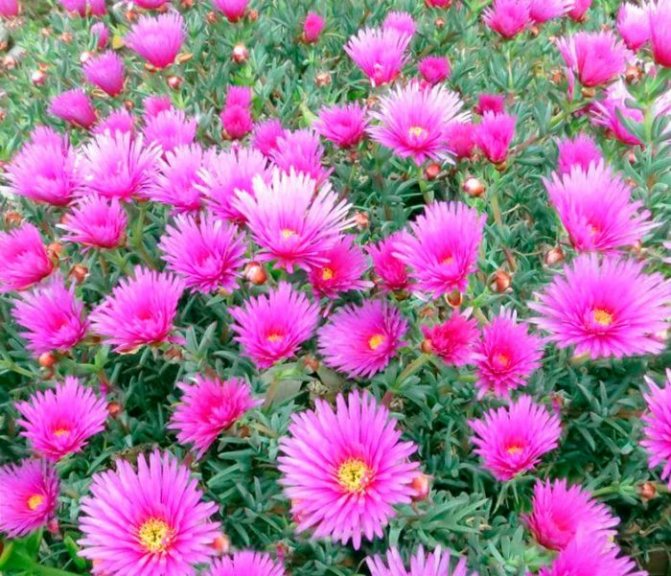
The genus mesembriantemum is represented by not very tall creeping or creeping plants, and in some cases by shrubs, not more than 15 centimeters high. Strongly branching recumbent shoots are usually straight. Fleshy sessile leaf plates of greenish color have a fusiform or rounded shape. In the upper part of the stem, they are placed alternately, and in the lower part, opposite. On the surface of the leaf plates there are superficial swollen cells called idioblasts, which outwardly look like small balls of crystal, because of them this culture is also called ice or crystal grass. The flowers of such a plant are similar to daisies. They are collected in brushes, or they can be single. Flowers are painted in a variety of colors: white, pink, red, and sometimes yellow. Such a plant blooms throughout the summer, and fades in mid-autumn. The fruit is a five-fold box with small seeds inside. They remain viable for 1-2 years. Grow this culture both indoors and in open soil.
Doroteanthus varieties
In addition to the species described above, interesting variegated varieties of dorotheanthus have been bred, distinguished by a rich color range and height of the bushes:
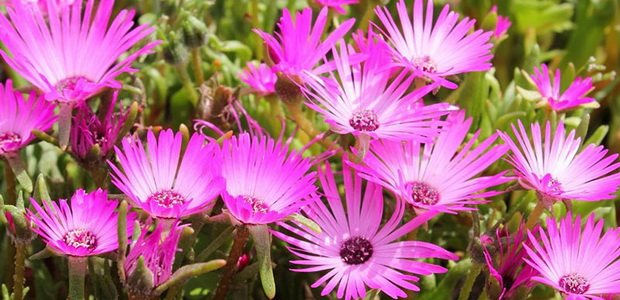

"Apricot pointe shoes" - bush 10-15 cm high with bright pink and light orange flowers;
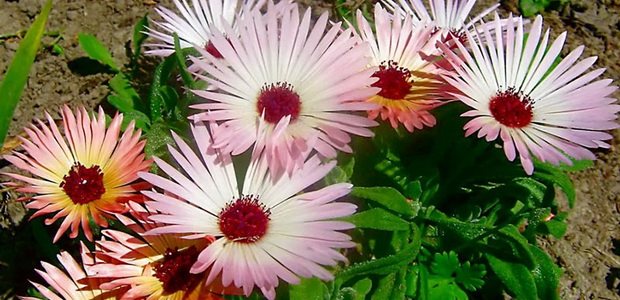

"Lemonade" - a variegated variety with flowers of yellow, orange, pink shades;
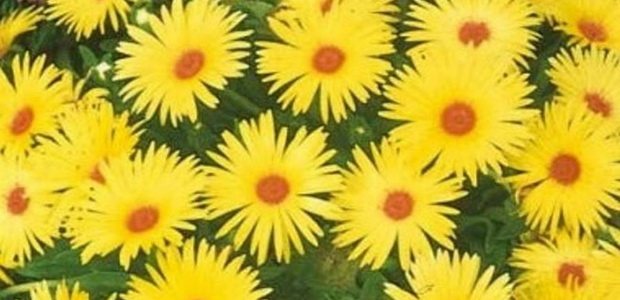

"Lunette" - a bush, abundantly covered with yellow buds with a rich red core;
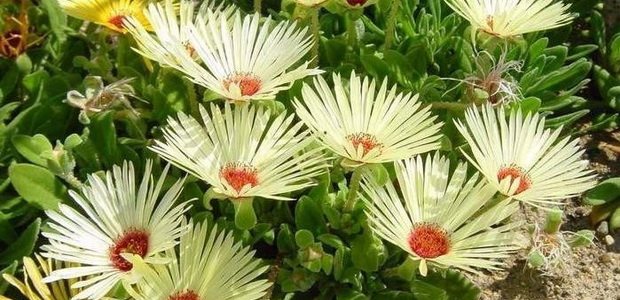

"Northern Lights" - has very beautiful flowers with green and greenish-yellow petals;


"Gelato Dark Pink" - a spectacular variety with double petals. It is purple on the outer petals, white on the inner ones;
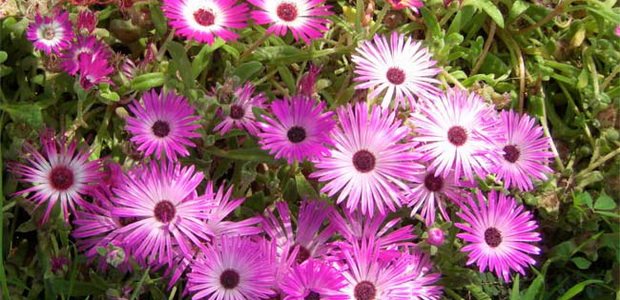

"Magic Carpet Mix" - flowers with a double color, which can be different;
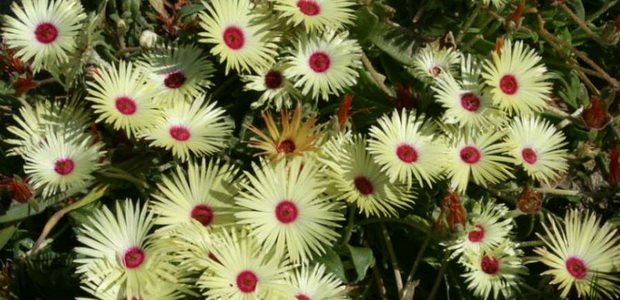

"Pastel mixture" - undersized plants up to 10 cm in height with flowers of light pink, pale yellow, cream, white colors;
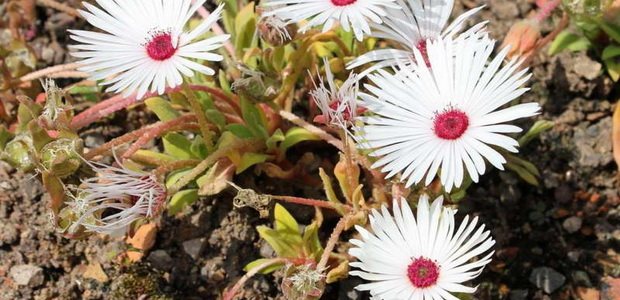

"Merry round dance" - bush 25 - 35 cm high with double color of petals. Their yellow upper part smoothly turns into a light yellow hue. The core is dark red;
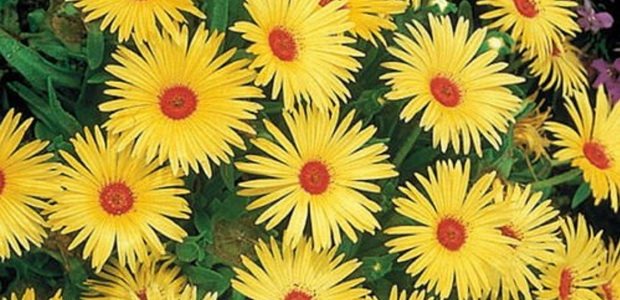

"Yellow" - a variety with intense yellow flowers with a red heart;
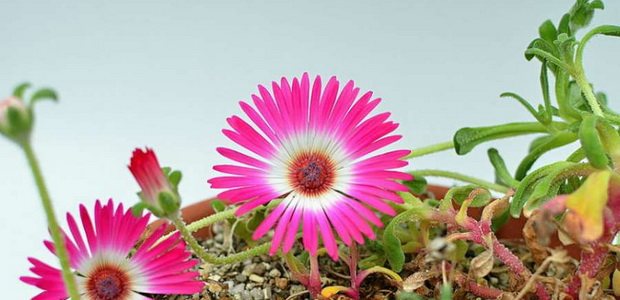

"Magic Carpet" - differs in the unusual color of the petals of a pale pink color with a white edging along the edge.
Caring for the mesembriantemum at home
Growing from seeds
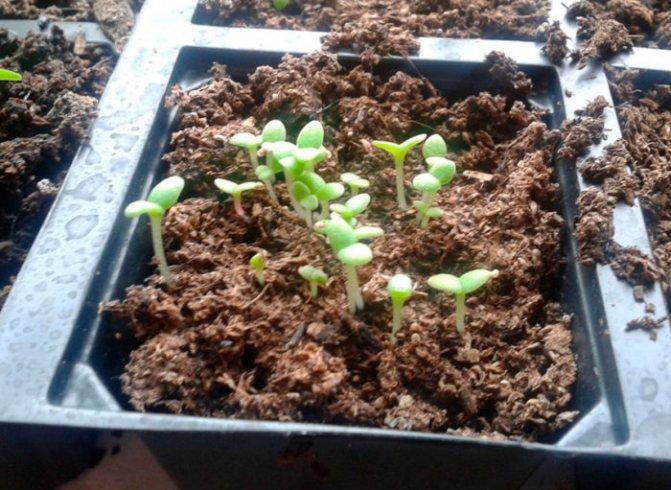

Sowing the seeds of the mesembryanthemum directly into the soil is possible only in the southern regions. In middle latitudes, seedlings of such a plant are first grown, while sowing is carried out in the first half of April. It is not worth sowing seeds earlier, because the seedlings need a lot of light. To grow seedlings, you need a breathable light soil mixture, which should consist of coarse sand, peat and garden soil (2: 2: 1).
The substrate must be disinfected before planting, for this it is calcined in the oven or spilled with a solution of potassium permanganate. Then the surface of the soil mixture is leveled and removed to a warm place for 15 days, during which time the beneficial microorganisms necessary for the plants should multiply in the substrate. The seeds must be evenly distributed over the surface of the soil mixture, which must be pre-moistened, then they are slightly pressed into the substrate, but not covered with the substrate. The container must be covered with glass or film, and then it is removed to a well-lit cool (15-16 degrees) place, before the seedlings appear. After about 7 days, the first seedlings should appear, when this happens, the plants are removed to a cooler place (from 10 to 12 degrees). The mass appearance of seedlings occurs only after 3-4 weeks.
How to water and feed
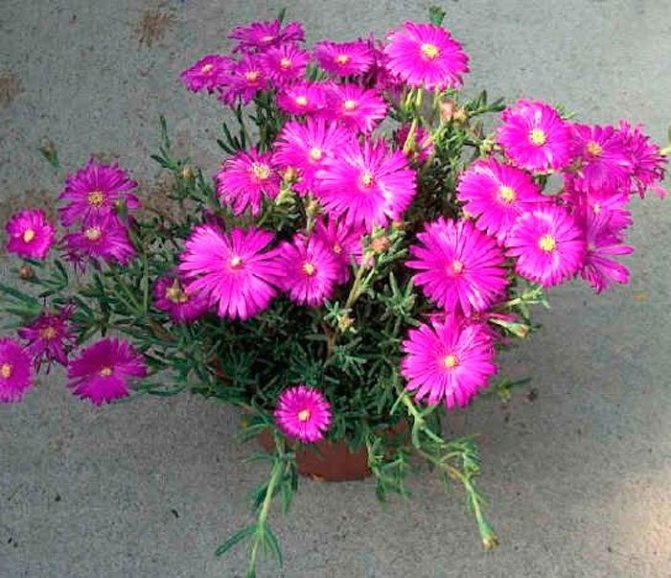

The development of fragile seedlings is extremely slow, and they also do not have resistance to root rot, in this regard, in order to grow seedlings of such a culture, it must be properly watered. The greenhouse where the seedlings grow should be well ventilated, while the soil mixture should always be slightly damp. To moisten it, you must use a spray. After the plant grows stronger, and they have 2 true leaf plates each, they should be cut into individual containers (plastic cups or pots), which are filled with the same soil mixture, but it should be noted that there should be a lot of sand in it. It is not necessary to feed such a plant during the seedling period.
Interesting: Canadian roses
How is crystal chamomile used - mesembriantemum
Variegated bright bushes with unusual leaves can decorate any flower garden, give the site a special charm and originality.
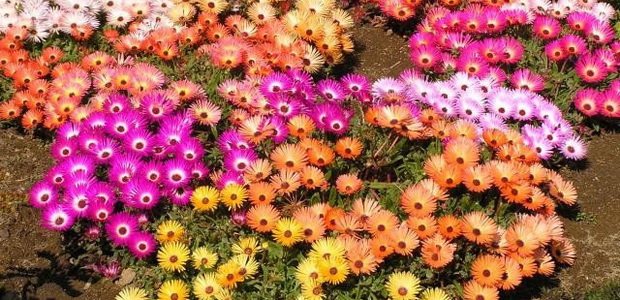

A low flower looks very nice along the borders. In this case, you can plant it in combination with other low-growing plants or combine several varieties of dorotheanthus of different colors.


Crystal chamomile - mesembriantemum is indispensable for decorating a variegated flower bed, which, with its appearance, will shimmer with a wide variety of shades. The flower is especially beautiful on rocky hills, small slopes. It is also suitable for creating alpine slides.
With its help, they fill the voids on the site, using it as a variegated carpet. Low-growing ground cover varieties are suitable for this.
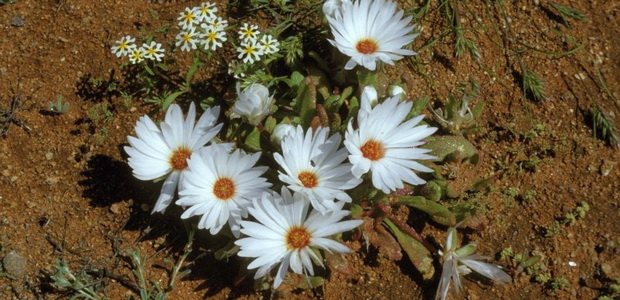

Harmonious neighbors for this culture are marigolds, pansies, begonias, zinnias, vervains, stemless thorns, phlox, alissums and many others.
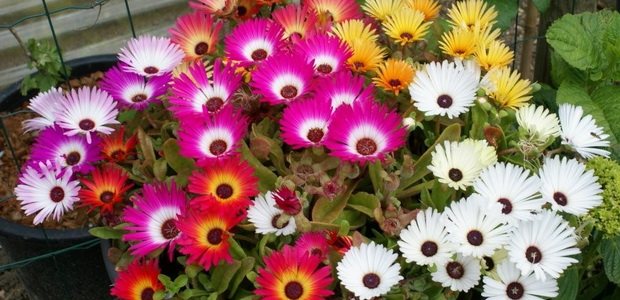

Dorotheanthus is often used as an ampelous plant. It can be grown at home in a container or flowerpot, and in spring, with the onset of warm days, it can be taken out on a terrace or veranda.In regions with a warm climate, flower pots are put on the site for the entire summer season and are brought in only in late autumn with the arrival of cold weather. From autumn to winter, the flower serves to decorate the room.
Further on the page you can see a photo of dorotheanthus flowers (mesembriantemums) in a flower garden and understand how they look in different compositions, how they are combined with each other and with other ornamental plants:
Planting and caring for the mesembriantemum in the open field
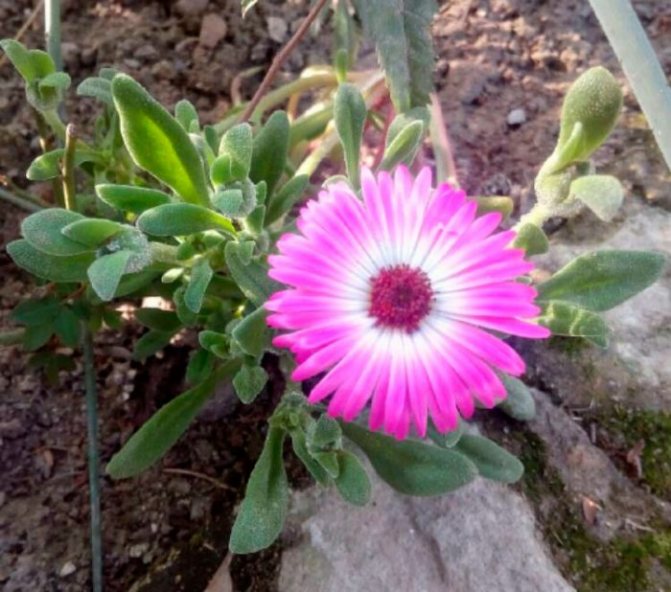

What time to plant
In open soil, seedlings of mesembryanthemum should be planted only after return spring frosts are left behind, and warm weather sets in, while the earth should be well warmed up, as a rule, this time falls on the second half of May or the first days of June.
To grow such a crop, it is recommended to choose a ventilated area that has reliable protection from drafts and is illuminated by the sun throughout almost the whole day. These flowers will grow best in an area located in the southern part of the garden. The soil should be well-drained, rocky or sandy. Before you start planting, you should dig up the soil, while you need to add expanded clay, as well as sand. This plant is not recommended to be planted near moisture-loving crops, the fact is that the bushes rot in excessively moist soil.
Landing rules
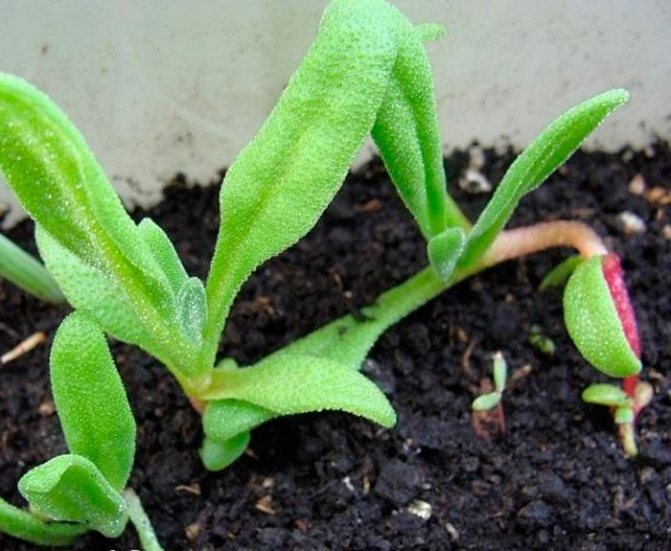

It is very easy to grow a mesembriantemum in your garden. Before proceeding with planting, it is necessary to make planting holes in the prepared area, while their depth should be such that the plant can fit in them along with a lump of earth and roots. A distance of at least 15–20 centimeters should be kept between the pits. After planting seedlings, the free space in the planting pits must be covered with moisture-permeable loose soil. When the plants are planted, the soil needs to be watered and tamped a little.
How to care for the garden
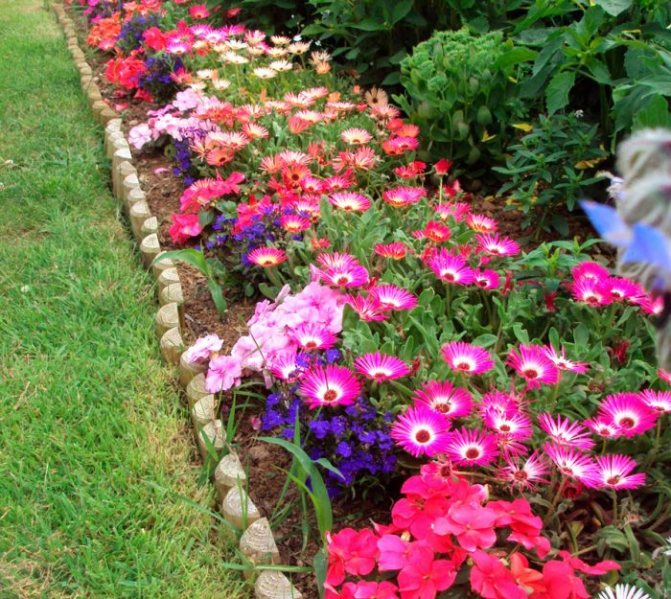

Watering such flowers is necessary in moderation and in a timely manner. Watering is carried out only when the soil dries well and it will be seen that the bushes are suffering from a lack of water. If it often rains in the summer, then such a culture can be very badly damaged, in this regard, experts recommend covering the site with a film in wet weather, as a result, the soil will not sour from water. The plots are fertilized once every 15–20 days. For feeding, a solution of complex fertilizers for succulent plants is used.
You do not need to cut the bushes, on the contrary, the flowering shoots creeping along the site turn the flower bed into a motley spectacular carpet. If you take care of the bushes correctly, then their flowering can last until the second half of the autumn period.
Wintering
Bushes for the winter must be removed from the soil, while all excess soil must be removed from the root system. They are stored for storage in a cool place (from 10 to 12 degrees), while in spring, when the growing season begins, the bushes must be cuttings. Rooting of cuttings should be carried out with poor watering and under diffused bright light, and when frost passes, they should be planted in open soil.
Breeding and care
African chamomile - an amazing plant that gives out a whole "carpet" of bright colors. Some gardeners are afraid to breed it due to the strong love of Mesembriantemum for the scorching rays of the sun. But there is no need to be afraid. The result will exceed all expectations.
When choosing a land area for cultivation of Mesembriantemum, one should take into account the following aspects:
- Lighting is the most necessary condition for planting this type of plant. It is necessary to choose that part of the site where the sun is for the longest amount of time during the day.
- The plant does not like drafts. A well-ventilated place is required, but no drafts.
- In no case should you plant a mesembriantemum in the shade. With insufficient light, the plant will simply stop developing.
- The species of the Aizov family prefers light sandy or rocky soil that allows water to pass through.
- Mesembriantemum needs fertilizing in the form of mineral fertilizers, which must be added at the stage of plant development during the formation of buds ..
- Like any other plant, Mesembriantemum is not adapted to increased moisture and dampness. Watering should be discreet. This procedure is only suitable for young and potted specimens. Excessive moisture causes rapid root decay.
Diseases and pests of the mesembryanthemum
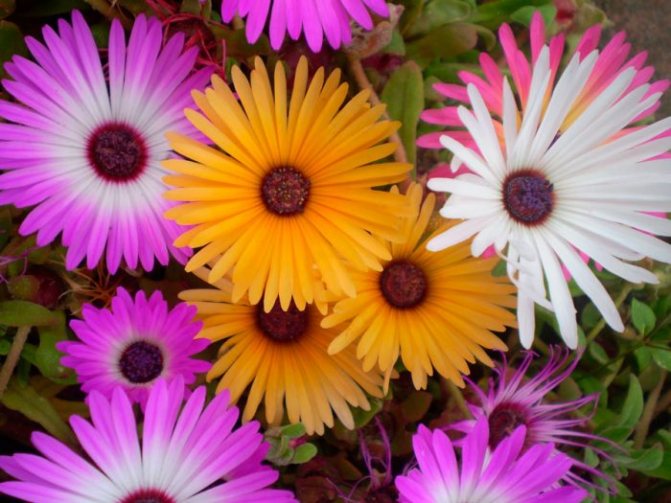

Diseases
This crop, when grown in open soil, has a fairly high resistance to both diseases and harmful insects. Most often, it suffers due to unfavorable weather conditions, or rather, high humidity or due to improper irrigation. If moisture stagnation is observed in the soil, then the bushes can be affected by root rot, while it is almost impossible to cure diseased plants. You can prune the affected areas of the root system and spray the bushes with a fungicide, but the chances are that this will not help them.
If the bushes are planted in a shaded place, then they may not bloom at all, because they need a lot of sunlight, while direct rays do not harm them at all. If the mesembriantemum lacks light, then it will become elongated and take on a painful appearance. Also, bushes become less attractive if they lack the nutrients in the soil.
Harmful insects
Spider mites can settle on the bushes, which prefer to live in exactly the same conditions as the mesembriantemum, but these pests can suffer due to high humidity. To get rid of ticks, you need to use acaricides, for example, Aktara, Fitoverm, Aktellik or Akarin.
Interesting: Damask rose
Propagation by cuttings
When harvesting cuttings, they adhere to the following scheme: in the fall, you need to outline a bush that needs to be dug up and placed in a dark, cool place, where it will be stored until spring. When the time comes, cuttings are cut from it, which must be placed in wet sand for rooting. Three days after planting, the plants are kept in "dry mode", since a certain time must pass for them to adapt. The appearance of leaves on the cuttings is a good signal - it means that the cuttings were able to take root. After waiting for the end of the last frost, you can choose a site for transplanting seedlings to a permanent place
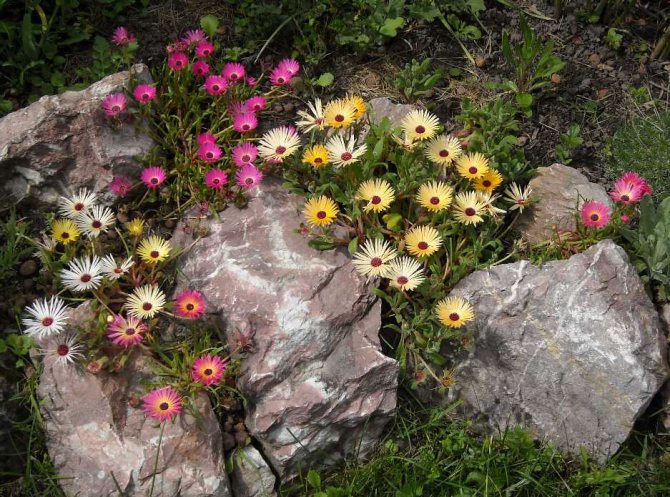

Types and varieties of mesembriantemum with photos and names
Today, gardeners cultivate not a very large number of varieties and types of mesembryanthemum; their description will be given below.
Crystal mesembryanthemum (Mesembryanthemum crystallinum)
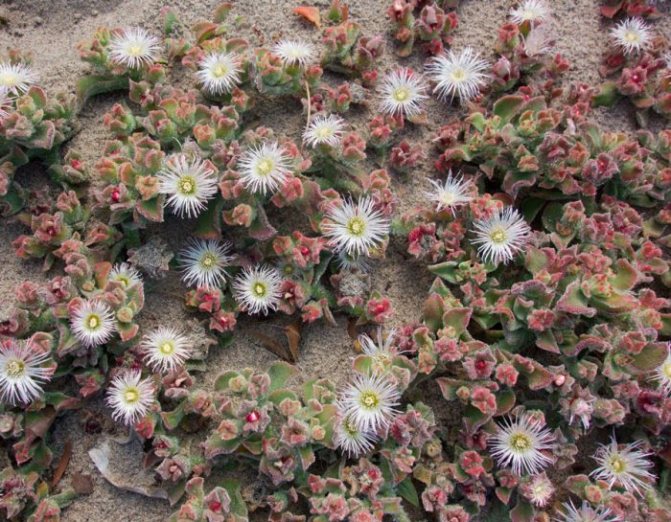

Or mesembriantemum crystallinum, or crystal grass. This species comes from the deserts of South Africa. Such a wide-spreading perennial reaches a height of about 15 centimeters. It has a large number of shoots, which adorn small, fleshy leaf plates of an oval shape and greenish color, while their edges are wavy. The flowers are outwardly similar to daisies or daisies. This view is described in more detail at the beginning of this article. The following varieties are popular:
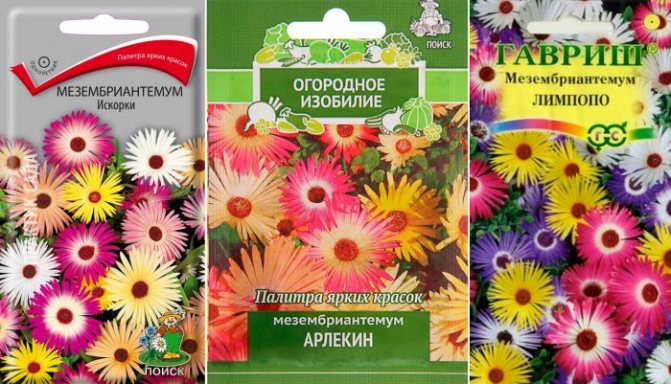

- Sparkles ... The leaf plates are whitish yellow. The flowers have different colors, and in diameter they reach about 45 mm.
- Harlequin ... The petals have a double color, namely, pink and orange.
- Limpopo ... This variety includes varieties of various colors.
Mesembryanthemum gramineus, or tricolor
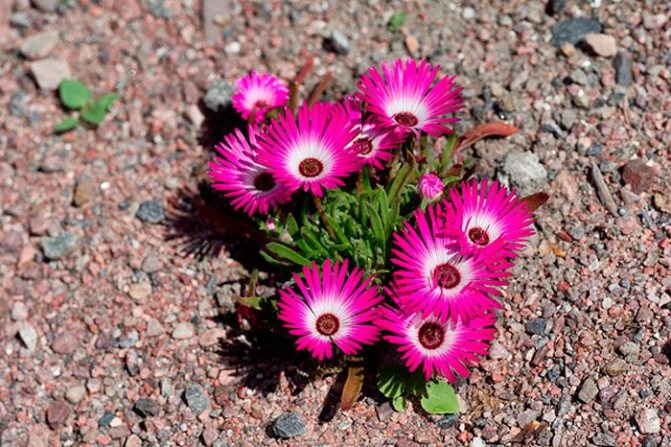

Such a branchy annual reaches a height of 12 centimeters. Shoots have a pale red color.Fleshy linear leaf plates reach 50 mm in length, while there are hairs on their surface. The color of the flowers is carmine pink, closer to the middle they are painted in a darker color shade, in diameter they reach 36 mm.
Daisy mesembryanthemum (Mesembryanthemum bellidiformis), or hairy mesembryanthemum
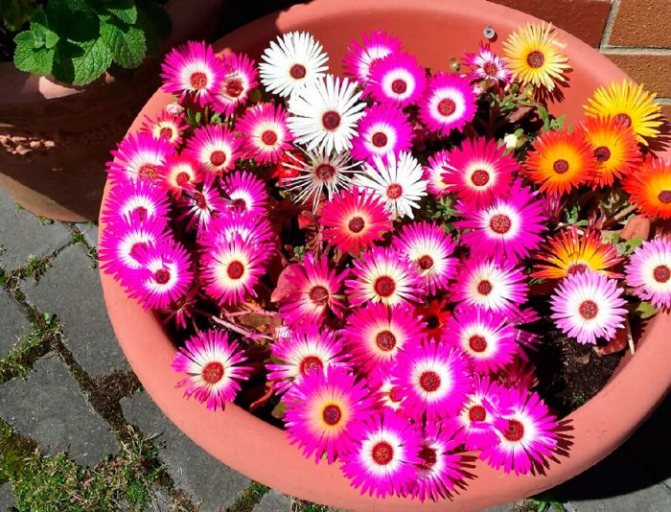

An annual branched plant reaches a height of 10 centimeters. The length of the fleshy leaf plates is about 75 mm, they are obovate, and there are papillae on their surface. The flowers reach 30-40 mm in diameter, they are colored pink, orange, bright purple, red, apricot, yellow or purple. Their disclosure takes place only on a fine day.
Cloudy mesembryanthemum (Mesembryanthemum nubigenum)
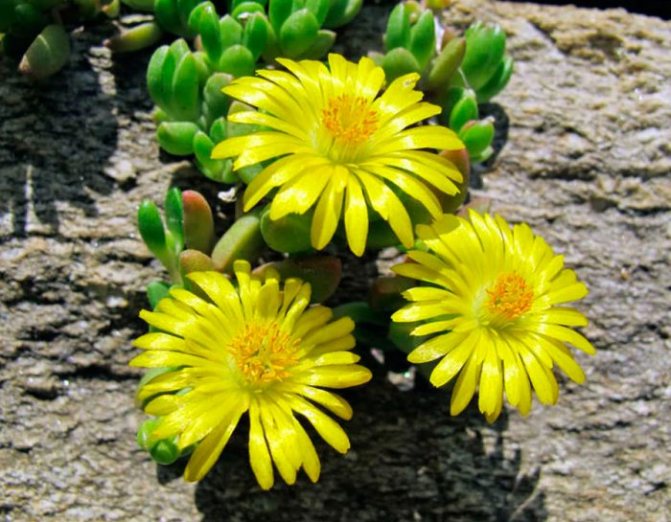

This succulent is cultivated as a ground cover plant, but in natural conditions it is a semi-shrub. The height of the bush varies from 60 to 100 mm. The leaf plates are oval or linear. When the temperature drops, the bushes turn bronze. The species is hardy and has a short flowering period. Narrow petals can be yellow-golden, orange, red or purple. The diameter of the flowers is about 35 mm.
Mesembryanthemum occulatus
The species has an unusual color, which explains its great popularity among gardeners. The petals are deep yellow, while the stamens, pistil and center of the head are bright red. The height of the bush is about 10 centimeters. The length of the spatulate-lanceolate leaf plates is 10–45 mm.
Types of dorotheanthus
Dorotheanthus daisy (Dorotheanthus bellidiformis).
Perennial ground cover plant 12-15 cm high with soft, lying shoots. The leaves are narrow, lanceolate, up to 8 cm long, with small shiny villi on the surface. Juicy inflorescences of white, pink or red color with a dark middle, 3-5 cm in diameter. The buds open only in bright sunlight, in cloudy weather they are closed.
Dorotheanthus gramineous, or tricolor (Dorotheanthus gramineus).
This species has numerous creeping, intertwining thin shoots of a purple hue. The height of the bush can be 10 - 25 cm. Leaves are petiolate, elliptical, rounded at the end, fleshy, up to 5 cm long and up to 1 cm thick. Flowers 3 - 4 cm in diameter, red or pale pink color with a more saturated center.
Dorotheanthus oculatus (Dorotheanthus oculatus).
It is a bush about 10 cm high. It has fleshy, linear, rounded at the end leaves up to 1 cm wide. Flowers with a diameter of 4 - 5 cm, red, pink, white, cream shade with red stamens in the central part.
It is much less commonly used in horticulture compared to other varieties.
Varieties and varieties of mesembriantemum
In our area, mesembriantemum can be found infrequently, and seeds can not be bought in every store. But growers who have chosen this plant for their garden remain its fans forever. This flower is called crystal or glass chamomile for its succulent leaves covered with dewdrops. And this handsome man got the name "midday flower" due to the fact that the bright inflorescences of the mesembryanthemum are open only on sunny days.
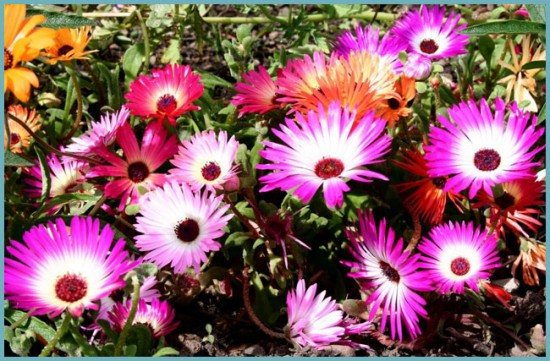

At least 50 species of mesembryanthemum are known. These are both perennial and annual plants of small height (7-10 cm) growing with a chic carpet, because the mesembriantemum has very decorative not only flowers, but also leaves.
Most often you can find the following varieties:
- The mesembriantemum is hairy. The second name is dorotheanthus daisy. The flowers are small, up to 3.5 cm in diameter, of various colors.
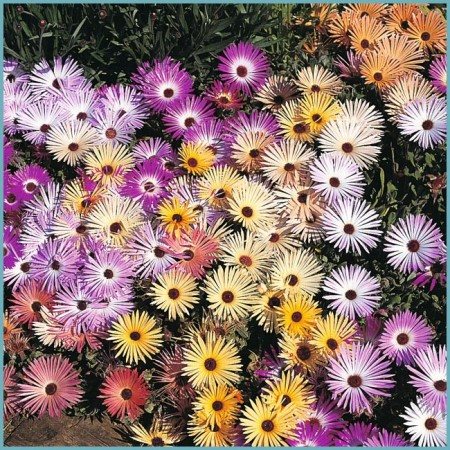

- Mesembriantemum ocellar ... Owner of yellow flowers with a red core.
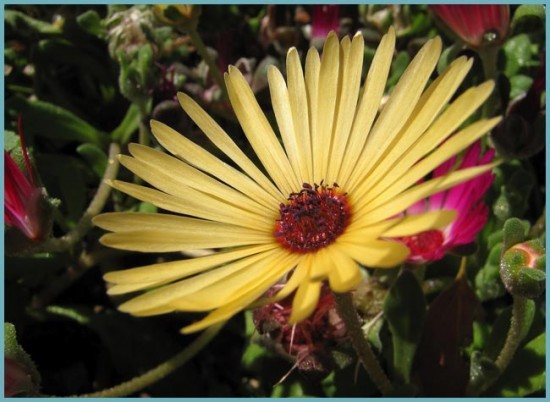

- Crystal mesembriantemum. The most demanded variety.The owner of a large number of leaves with hairs similar to droplets.
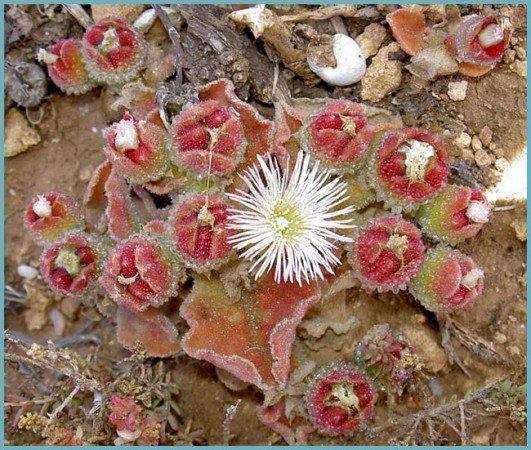

Advice. When planting plants of the same species, it is necessary to observe spatial isolation.
Description of the plant
Mesembriantemum is a small succulent (about 15 cm in height). Shrubs are usually creeping or creeping. Plants of the genus Aizovyh are thermophilic, located mainly in sunny places with sand. Stems are straight, recumbent, widely branched. The leaves are densely arranged, have a light green color, thick, oval in shape. The lower ones are located diametrically, and the middle ones are spiral. The inner part of the leaves does not have chlorophyll, as it performs the function of water filling.
Mesembryanthemum flowers, as a rule, have a terry surface, resemble chamomile in structure. Single or racemose inflorescences. The petals are narrow, multiple. The color of the mesembryanthemum is:
- pinkish;
- scarlet;
- lactic;
- yellow;
- peach.
The duration of the complex of physiological processes of sexual reproduction that occurs in flowering plants in the period from the inception of a flower to fertilization lasts almost the entire summer period until the first cold weather.
Planting mesembryanthemum
The germination capacity of mesembriantemum seeds is guaranteed to be stored for two years. The seeds themselves are very small: 1 g holds at least 3000 seeds.
It is interesting: What flowers can be planted in the country in the autumn
Given that the homeland of this flower is hot countries, planting must be done in well-lit places, preferably from the south side. The soil is best suited to sandy loam, light. One of the important rules is good drainage.
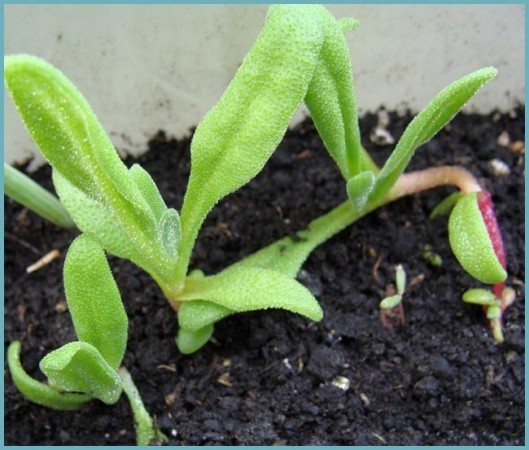

In open ground, seeds can be sown exclusively in the southern regions in late spring. When shoots appear, they will need to be thinned out, leaving only the strongest seedlings.
Advice. The space between the plants should be about 20 cm.
In cooler conditions, the mesembriantemum is sown for seedlings in March or April. For good germination, you need to adhere to a simple mechanism of action:
- The seeds are sown into the soil and a small layer of calcined sand is poured on top. The boxes are covered with foil.
- The boxes must be placed in the light and watered sparingly, avoiding an excess of moisture, which can lead to rotting of young growth.


- When the young growth gets stronger, it must be seated in separate containers.
- In May, you can plant seedlings in open ground, if by this time the soil has warmed up, and the return frosts have passed.
Mesembriantemum varieties
The flowering time of a plant depends not only on the sowing time, but also on the variety, which must also be taken into account. The mesembriantemum is hairy. Most often in gardens and parks you can find this variety, which is often called the daisy dorotheanthus. The flowers are not very large, do not exceed 3.5 cm in diameter. They differ in a variety of shades. Mesembriantemum ocellar. This variety is also one of the most commonly used in landscape design. It has yellow flowers that look spectacular because of the red center. Crystal mesembriantemum.
It is the most popular among the known varieties. Of the features of the plant, it is worth highlighting the presence of many fleshy leaves. The name is associated with glandular hairs that resemble drops. "Frost". It is one of the rare varieties that was bred by domestic breeders. In addition to the above, there are other varieties bred by foreign experts, which have become widespread for decorative purposes. Although in general terms these mesembryanthemums are similar, it is still important to maintain a certain distance between them when planting.
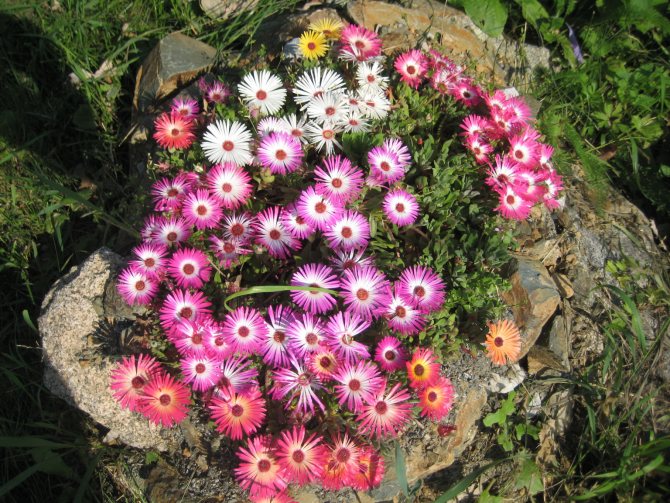

Mesembriantemum care, fertilization and feeding
The most important thing in caring for this wondrous flower is to provide a sufficient level of lighting.If the plant lacks light, it will stretch and slow down flowering. With the right lighting, the mesembriantemum blooms very profusely, turning the beds into a multi-colored blooming carpet.
As mentioned above, the plant belongs to succulents, and, like all of them, does not tolerate excess moisture well. If your pet has an excess of water, leave it until it is completely dry.
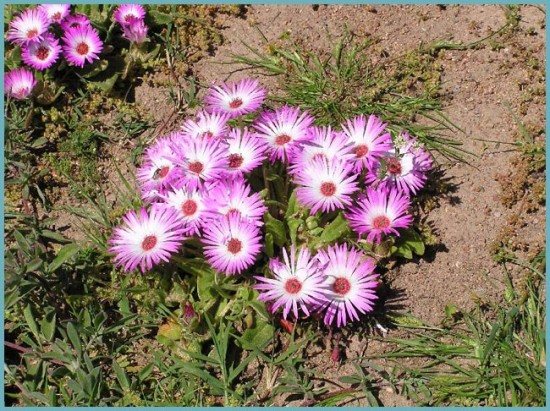

It is recommended to transfer perennial plants for the winter to a greenhouse with heating or a room in which the temperature does not drop below 5 degrees. When the temperature reaches zero, the mesembriantemum usually dies.
Top dressing is applied twice a month during the summer period.
In general, the mesembriantemum is not susceptible to diseases and is quite resistant to pest attacks. Occasionally, a spider mite can be found on a flower.
When to sow mesembriantemum for seedlings
Sow mesembriantemum in late March or early April. Earlier sowing will lead to stretching of seedlings (lack of light affects). Seedlings become brittle, develop poorly.
How to sow
- seeds are scattered over the surface as rarely as possible, it is better to immediately use a toothpick and place them at a distance of 2-3 cm, so that later they do not break through, damaging the roots.
- lightly sprinkle with sand on top;
- the embedment depth does not exceed 2 - 3 mm;
- maintain the temperature + 12-15º C;
- crops are sprayed from a spray gun, covered with a film;
- seedlings emerge on 7-8 days (the main ones - after 21-28 days), then the film is removed, transferred to a light windowsill without drafts;
- too elongated seedlings are treated with retardants, which slows down excessive growth in length and increases cell division of the stems in width;
- watered sparingly, avoiding root rot;
- the temperature of the content is reduced to + 10ºC;
- grown seedlings, at the stage of appearance of two to four true leaves, dive in separate pots or cassette cells.
- Further care consists in maintaining a moderate moisture content of the substrate, providing bright diffused lighting and a cool temperature of the content in the range of 10-16 ° C.
Reproduction of the mesembryanthemum
In addition to seed propagation, cuttings can also be used. To do this, uterine bushes are placed in greenhouses for the winter and kept at a temperature of 10 ° C. And in March, the cuttings are planted in sandy soil and placed in sunny places. With proper moderate watering, the cuttings root very quickly and grow into neat bushes.
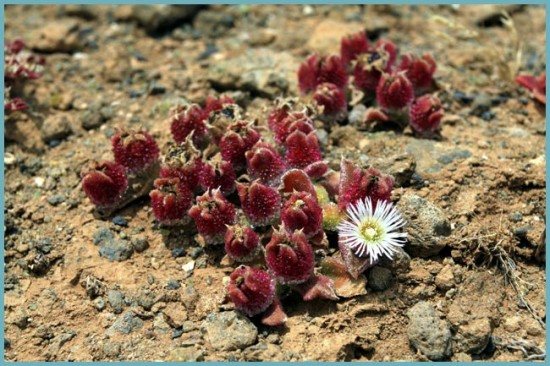

Breeding rules
Reproduction of this plant is possible in two ways:
- Seeds.
- Cuttings.
For seed propagation, seedlings begin to be prepared in February-early March. The plant is sown in a moisture-accessible soil mixture with a predominant predominance of sand. Seedlings are firmly covered with plastic wrap until the first sprouts grow. The temperature required for seed germination is 13-17 degrees. Then the temperature is lowered to 10 degrees. After one month, the sprouts are divided and planted in different pots. Mesembriantemum is planted in the main place only in May.
For propagation by cuttings in early March, shoots used for vegetative propagation are taken from adult plants and placed in separate pots. Young specimens are planted in the ground in May.
Mesembriantemum in landscape design and in combination with other plants
Mesembriantemum looks great in combination with many tall flowers, for example, bells and roses. It is generally universal in landscape design. Its bright flowers can be used to emphasize the line of the border, or you can create a beautiful monoclumba from some mesembriantemums.
In addition, it is often planted as a ground cover plant. When the bulbs have faded, the mesembriantemum will continue to bloom brightly until the end of autumn.
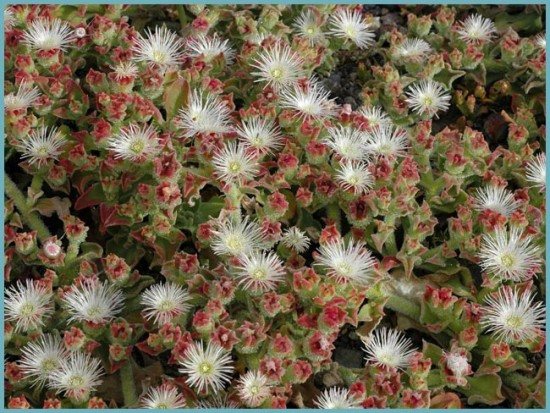

A welcome guest will be the mesembriantemum in the rock gardens, because the bright flowers of absolutely fantastic colors against the background of various stones simply fascinate the eye. He will feel good on the southern slopes.
The brightness and grace of the mesembryanthemum can decorate both the shore of an artificial reservoir and divert attention from an unsightly fence.
Mesembriantemum can be grown in pots and pots that can be used to decorate any terrace, balcony or house.
When choosing a place for a mesembryanthemum in landscape design, there is only one condition - good illumination. Everything else is limited only by your imagination. The unpretentiousness of this flower allows you to plant it anywhere. Perhaps a photo of this flower will help you choose the best place for it.
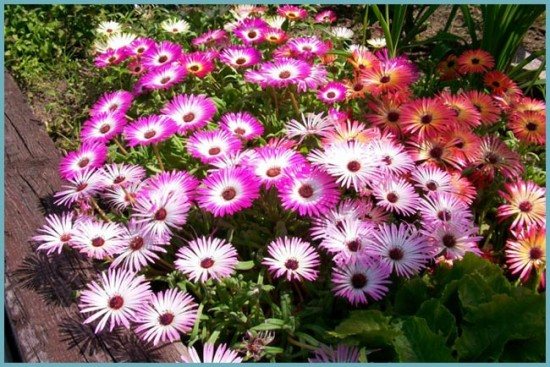

Due to its thermophilicity, mesembriantemum is not very widespread in our gardens. If you are unable to provide the flower with illumination, then it is better not to start growing it. But if these difficulties do not scare you, then the mesembriantemum will thank you with fabulous beauty and bright flowering. And since mesembryanthemums are great for planting not only in open ground, but also for growing in pots, containers and flowerpots, you can decorate both your garden and your home.
Conditions for growing dorotaentus
Location. The plant is very light-loving, therefore, if the goal of the gardener is to get a lush, bright bush with numerous buds, you should choose open areas for it. In other conditions (in the shade or partial shade), flowering will be poor.
The soil. Soils should be light, water and breathable, preferably sandy. The plant is extremely unpretentious to soils, it can grow even in poor and stony areas. The main condition for good growth is the absence of a close location of groundwater. Excessive moisture can harm the dorotheanthus.
Top dressing. This culture does not need additional feeding. Fertilizing the site is required in the fall, after the bush has faded. A complete mineral complex can be used to enrich the soil.
Watering and other care. The area near the bush is moistened immediately after planting the seedling. The next watering is needed only after 2 - 3 weeks, depending on weather conditions. In dry periods, watered once a week. After irrigation, it is necessary to loosen the soil in order for oxygen to reach the roots faster.
Shelter for the winter. Dorotheanthus is not only drought-resistant, but also quite cold-resistant. When breeding it, you do not need to take care of the shelter.
Growing problems. This plant is rarely exposed to diseases and pests. As a result of improper care, namely, due to excessive soil moisture, root rot is possible. Sometimes the bush is attacked by snails and slugs, which, when discovered, are collected by hand.
How the dorotheanthus (mesembriantemum) flower should be taken care of after planting in open ground is shown in detail in the selection of photos below, after looking at which, even a novice gardener can figure out the peculiarities of the work:
Botanical description
The stems of the flower are diverse: erect or recumbent, creeping, ascending, necessarily thickened, juicy, up to thirty centimeters long. The processes are covered with shiny "cilia". Dense, fleshy leaves have papillae-reservoirs filled with sap, shining in the sun like ice crystals.
How crystal chamomile blooms
Flowers with narrow petals, varied in color - white, pink, red, yellow, purple, lilac. A luxurious green carpet dotted with charming multi-colored flowers looks amazing. The inflorescences are large enough, up to seven centimeters. Bright "suns" are revealed only during the day, in clear weather. In cloudy - only no less interesting leaves will decorate the garden.Flowers with positive energy cheer you up, and the unusual crystal Mesembriantemum consoles with beauty, even when all summer flowers fade.
Further, a fruit resembling a box is formed. There are countless tiny seeds: one gram holds no less than three thousand. Among the many species are perennials and annuals.
Content
- Description
- Mesembriantemum at home Growing from seeds
- Watering and feeding
- When to plant
- Diseases and their treatment
- Crystal mesembriantemum (crystallinum)
How to plant seedlings of mesembryanthemum in the ground
- planted in open ground in the second decade of May or early June at a constant temperature of at least + 6º C, after the threat of frost passes;
- planting scheme 10x15 cm. For varieties with long shoots - up to 30 cm;
- landing site - sunny, southern slopes.
Crystal mesembriantemum prefers extremely light soil with a weak fertile layer and excellent drainage. To save the stems and leaves from decay, small stones are laid out near the bushes.
Mesembriantemum or sparkle flower
Mesembryanthemum (Mesembryanthemum) is a plant from the clove family, undersized, ground cover shrub. Literally translated, the name means "blooming at noon." This plant is known to flower growers as crystal chamomile. This is a thermophilic plant, its homeland is Africa. It also grows in Australia and southern Europe (in Italy, Portugal and Spain). Prefers dry, sandy soil. Loves the sun. This plant is a succulent plant that has special "pockets" in the tissues in which moisture accumulates. That is why its stems are quite thick, as well as the leaves, which look very juicy and fleshy, filled with juice. It can reach a height of 30 cm. The flowers resemble a multi-petaled chamomile. Their color can be different: white, pink, lilac, yellow. Flowers do not last long, about 2 weeks, but new ones are not long in coming. After flowering, a seed capsule is formed. There are a lot of seeds and they are very small.
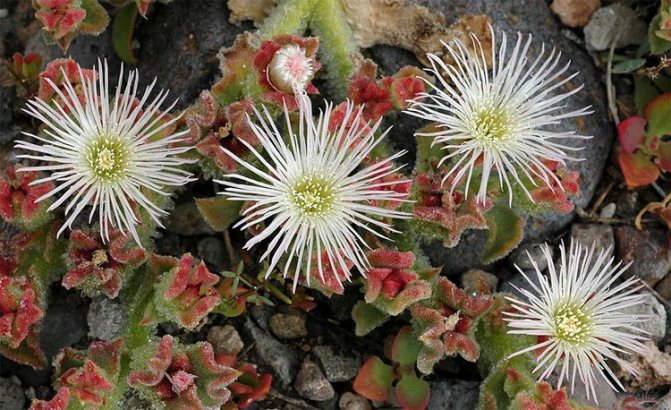

Mesembriantemum: photo
Healing properties
In 1994, in the course of scientific research in Lanzarote, the amazing healing properties of this plant were discovered.
Fresh juice of crystal grass is an excellent remedy for the treatment of numerous skin diseases, including such severe ones as neurodermatitis and psoriasis, and is used as an ingredient in medicinal baths, as well as in the manufacture of various medicinal ointments and cosmetic creams.
Based on this plant, various products are also produced to protect the skin from the harmful rays of the sun and treat sunburn.
Crystal herb can also be used for cosmetic purposes. Since its leaves contain 99% water, they can be used in the morning as a wash instead of lotion. This natural washing does not dry out the skin and does not cause irritation. In addition, shredded leaves can be used in place of soap.
Crystal grass
A pen pal sent me tomato seeds last year. In the envelope, I also found a transparent bag with small, like dust, seeds of an unknown plant - crystal grass.
"Is it worth sowing?" - I thought. There was almost no information about it, except that it looks amazingly beautiful and that in the fall, being in a vase of water, even without roots, it grows, blooms and can give seeds. In the spring, I sowed it in a small bowl on top of light soil and put it in a small greenhouse, where early cabbage was already sprouting.Occasionally moistened with water from a spray bottle, and after a week and a half, shoots appeared. Leaves - like drops of water These were unusual seedlings, such I have never seen. Tiny leaves are like emerald drops of water. When the sun's rays fell on them, they shimmered in different colors. After the seedlings got stronger, I prepared a light nutritious soil for picking it up: I mixed the soil from the garden bed, river gray sand and peat for seedlings in equal proportions. She dived with a fork, prying the plant from below, and transferred it into a glass with soil. Then lightly sprinkled and watered from a spoon under the root. I can tell you that the appearance of the shining "crystal grass" was so unreal that doubts never left me: will it take root? But everything went well, not a single root died, although I did not hide them from the sun. The glittering carpet kept the moisture in! The growth of these amazing plants began. I didn’t know what kind of crystal grass would grow, but somehow I guessed to plant it less often, not sparing the land. The distance between the bushes was gradually decreasing, although they did not strive for height. The twigs pressed to the ground, stretched in different directions. The previous impression was that there were water droplets on them, but they were quite hard to the touch. And the leaves took on bizarre shapes, increased in size and, of course, sparkled with all the colors of the rainbow in the sun. In general, the whole plant simply emitted light, it was impossible to pass by. By the middle of summer, mind you, almost without watering, the bushes of crystal grass closed in the garden bed, completely covering the soil. It was always cool under this sparkling carpet, the ground did not overheat. When in the fall I discovered that the roots of this grass are surprisingly small, I realized that my "crystal" beauty did not draw water from the ground at all, on the contrary, she kept it! Seeds - in the attic, and twigs - for souvenirs Once I went up to the garden bed, I saw fluffy white stars and realized: the crystal grass bloomed! It bloomed until late autumn, and the first buds managed to give boxes with seeds. I dried them along with the bushes, hung them in the attic by the roots. Now the shore, like the apple of an eye, until next spring. In the fall, at the exhibition of the Kursk club "Gardener", crystal grass conquered everyone with its unusual appearance and iridescent shine. The women instantly took apart her twigs for souvenirs. By that time, I already knew that the Latin name for this amazing plant is Mesembrianthemym cristalliym and it belongs to the Aizoaceae family. It turns out that crystal grass is 99% water. And that is not all. Photosynthesis changes The most interesting thing is that this plant is able to change its type of photosynthesis depending on the ambient temperature. In the spring, when the air is mostly cool and humid, the stomata on the underside of the leaves are open, and the grass absorbs carbon dioxide and gives off oxygen during the day. In summer, when it becomes dry, hot and the salinity of the soil increases, then the crystal grass switches to another type of photosynthesis, in which the stomata are closed during the day. As a result, water evaporation is reduced by 10 times. It can be said that this plant has phenomenal resistance to drought and salinity. I can already imagine how next summer the "crystal" carpet will protect my tomatoes from the extremes of night and day temperatures. With crystal grass, you can forget about mulching, it will retain moisture. What do you know about her? By the way, I also found information that crystal grass juice, when applied to the face, makes the skin smooth and velvety. To check, I plucked a piece of paper and rubbed it across her cheeks, then another. Surprisingly, the skin has become silky, the feeling of dryness has disappeared. So all summer I was rescued by "crystal" leaves, and at the end of autumn I sent them "in bulk" in the freezer, and in winter every day they reminded me of summer.And also, I thought, you can try to process the seeds of garden crops before sowing with the juice of these frozen leaves. I would like to know which of the gardeners was engaged in growing crystal grass more professionally? How can you diversify its application? How to harvest the seeds of this plant correctly? I would be glad to have any hints.
> Mesembriantemum: growing, planting, care and photo
Open ground varieties
In addition to the species that nature gave to man, there are also artificially bred varieties of mesembriantemum. It is they who are intended for growing outdoors in gardens and in backyard areas. The most popular types for outdoor use are described below.
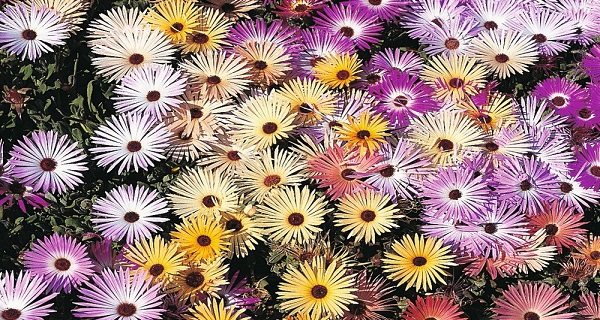

Harlequin
It is considered the most successful option for growing in the garden. Harlequin flowers are orange-pink in color. The plant literally spreads on the ground with its large flowers (5-6 centimeters in diameter). This variety can often be seen on curbs, rocky hillocks.
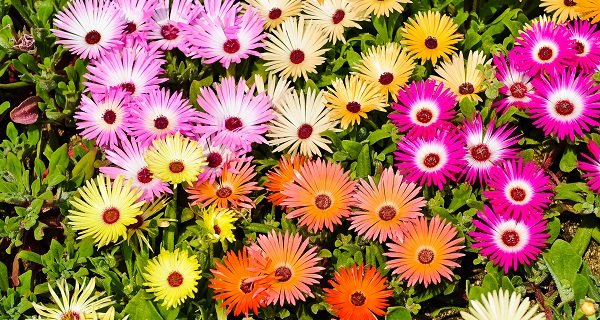

Sparkle
This variety is notable for its large flowers and white and yellow leaves. Flowers exist in orange and pink colors, however, there will always be a white border inside the bud (this is a remarkable feature of the variety).
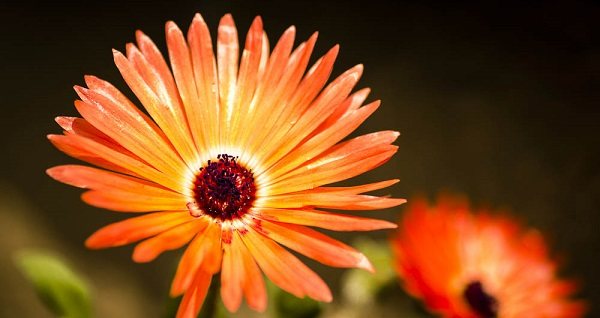

Frost
This variety was bred by our compatriots. Hoarfrost blooms with bright orange, yellow, pink flowers.
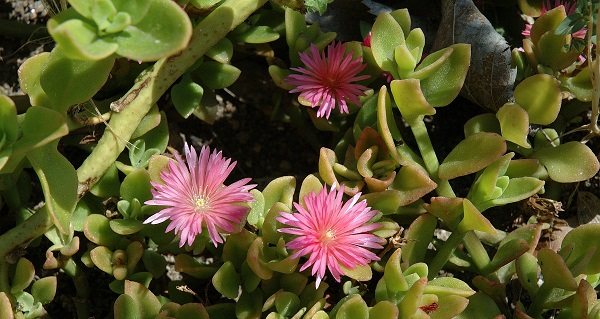

Limpopo
The peculiarity of this variety is its bright flowers that bloom from June to October.
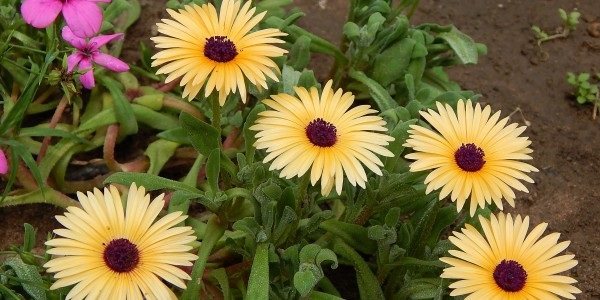

Lunet
This variety is a type of cereal mesembryanthemum. Its flowers have a red core, from which bright yellow petals diverge in different directions. This variety does not close in bad weather.
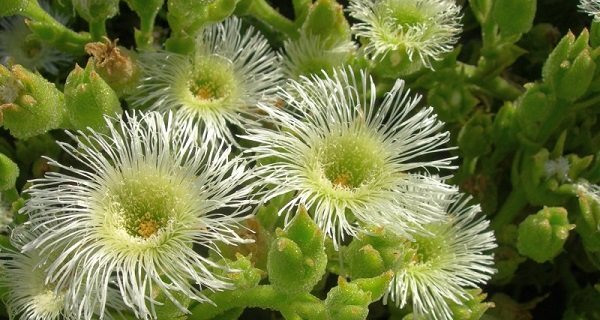

general information
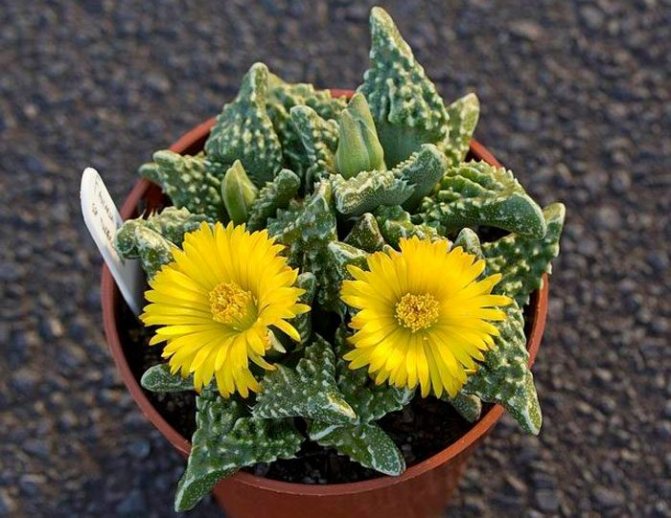

The plant genus Mesembryanthemum belongs to the Aizaceae family. This name was coined for the plant by Jacob Brain in the 17th century and is derived from two Greek roots meaning "flower" and "noon". It was originally spelled Mesembrianthemum. This name was chosen because the flowers of all plants belonging to this genus known at that time, opened only at noon, in sunny weather. At any other time, for example, at night or in the rain, they closed their petals.
Even in Russian literature, this flower is sometimes, by analogy, called "sunflower" or "midday".
However, already in the 18th century, varieties of this plant were discovered, the flowers of which opened at night. Then the name was slightly corrected by Johan Dillelenius, a botanist from Germany. The Latin name took on a modern look, and the new etymology suggested that it was formed from Greek roots, meaning "middle" and "embryo".
Mesembriantemum is an annual or biennial shrub up to fifteen centimeters high. It is a very short, sometimes creeping or creeping plant. It is classified as a succulent. Its stems usually lie on the ground, but are straight.
The leaves of all representatives are green, large and fleshy. Their distinctive feature is the indispensable presence of swollen cells on the leaves, which resemble crystalline droplets. Such an unusual structure gave this flower another name - "crystal chamomile".
The flowers of this plant can be either single or grow in inflorescences. They are like the flowers of daisies - they have many small, straight and narrow petals... Their colors, as a rule, are red, white or pink, sometimes yellow, but rarely. Small seeds are found in a capsule fruit.
Usually, the main homeland of the mesembryanthemum is called Southeast Africabut it grows in the wild in other places as well: for example, in South Australia, the Mediterranean and the Canary Islands.
Home care for the royal (royal) geranium
Sandy soils bathed in the sun are best suited for this flower.
Seed harvesting
Mesembryanthemum seeds can be bought, but if this annual plant is already available, you can prepare the material yourself:
- seed pods should be plucked;
- after that it remains to wait when they dry;
- dried boxes are dipped into a container with warm water;
- when soaked, the carpels open up and small brownish seeds can be removed;
- they need to be washed, spread out and dried in the open air;
- prepared seed material is laid out in paper bags for storage.
Main types
According to various sources, there are from fifty to eighty varieties of the genus Mesembriantemum. Not all of them are suitable for cultivation in flower beds - some grow only in the wild. Here are the most popular garden varieties:
- Crystal mesembriantemum is perhaps the most famous species of this plant. It is a short flower, found naturally in the Azores and Canary Islands and on the shores of the Mediterranean Sea. Its flowers resemble daisies with their long and narrow petals, and their hue ranges from white to pink and even red. This species has received many other household names: ice grass, crystallinum, glacier, crystal grass, crystal chamomile. All this is due to the unique leaves of the plant, as if strewn with crystal droplets.
- Mesembriantemum daisy is an annual plant ten centimeters high. It has many varieties with different shades: there are lilac, pink, red, yellow, orange flowers. It closes at night and in bad weather.
- Cloudy mesembriantemum is an evergreen bush up to ten centimeters high with thin and short leaves. Its flowers can be orange, golden or lilac. It is famous for its frost resistance, but it does not bloom for long. Its flowering period begins in late spring.
- Mesembriantemum cereal is an annual plant up to twelve centimeters high. Its branches have many branches, making the flower look unusually thick. The leaves are reddish and fleshy, three to five centimeters long. They creep along the ground, covering it tightly. The flowers have a carmine pink hue.
When and how to sow crystal chamomile seeds in the ground
In the southern regions, seeds can be sown in open ground no earlier than May, but the midday flower will bloom much later. The emerging seedlings must be thinned out so that the strongest specimens remain. The distance between them is about 20 cm.
African chamomile is very thermophilic, at most it can tolerate zero degrees for a short time. Fragile stems and the destructiveness of low temperatures - these are all the disadvantages of the plant. Otherwise, Mesembriantemum brings only joy. The flower garden containing ice grass is literally transformed.
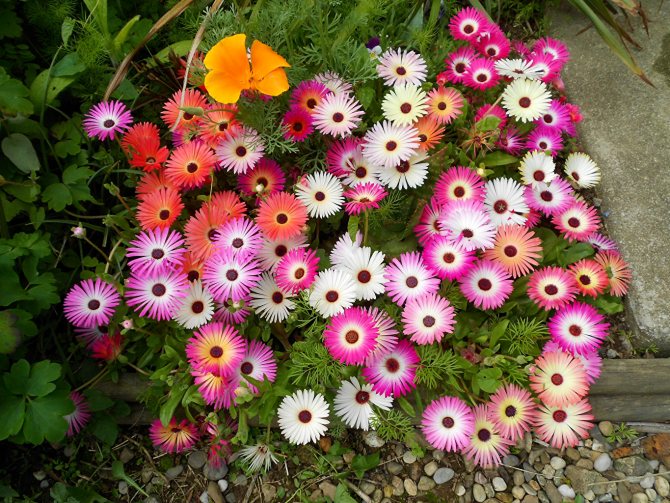

Mesembriantemum flower - description
Representatives of the genus Mesembriantemum are low creeping or creeping plants, sometimes dwarf shrubs, reaching a height of no more than 15 cm. Their stems are strongly branching, recumbent and usually straight. Leaves are sessile, fleshy, pale green, round or fusiform. In the lower part of the stems, they are located oppositely, in the upper part - alternately. On the leaves there are swollen superficial cells - idioblasts that look like crystal balls. Because of these cells, the mesembriantemum is called crystal or ice grass. The flowers of mesembriantemums are similar to daisies. They can be solitary or form racemose inflorescences. The color of the flowers is varied: pink, white, red and occasionally even yellow.
Flowering lasts all summer until mid-autumn. The fruit of the mesembriantemum is a five-leafed capsule with small seeds that do not lose germination for 1-2 years. This plant is grown both in the open field and at home.
Sowing mesembryanthemum in the ground can only be successful in the southern regions.In the conditions of the middle lane, seedlings are first grown, and then they are planted in a flower garden. Sowing seeds of mesembryanthemum for seedlings is done in early or mid-April.
There is no point in sowing seeds before, as the seedlings will need a lot of light.
Cultivation of mesembryanthemum is carried out in a light, breathable substrate, consisting of two parts of peat, two parts of coarse sand and one part of garden soil. The soil mixture is disinfected: it is fried in the oven or spilled with a solution of potassium permanganate, after which it is leveled and allowed to stand in a warm place for two weeks in order for microorganisms useful for seedlings to multiply in it.
In the photo: Growing mesembryanthemum in the open field
The seeds are scattered over the surface of the moistened substrate, trying to distribute them evenly, lightly pressed without covering, covered with film or glass and kept in a bright place at a temperature of 15-16 ° C until shoots appear. Seeds begin to germinate by the end of the first week, and as soon as you notice the first shoots, you need to lower the temperature of the content to 10-12 ˚C. Mass germination of seeds will begin only after 3-4 weeks.
Watering and feeding the mesembryanthemum
Fragile seedlings develop very slowly, moreover, they are not resistant to root rot, therefore, balanced watering is very important for growing mesembryanthemum seedlings. The greenhouse in which you are growing the seedlings should be well ventilated and the substrate should be kept slightly damp. It is best to moisturize it with a spray bottle.
Fortified seedlings with a pair of real leaves dive into separate containers - pots or plastic cups - with a substrate of approximately the same composition: sand should prevail in it. Before planting in the ground, feeding the mesembriantemum is not needed.
When to plant mesembriantemum
The mesembriantemum from seeds is planted in a flower garden when the soil warms up, warmth is established and the threat of recurrent frosts is over. Usually such conditions develop in the second half of May or early June.
For a mesembryanthemum, you need to choose a ventilated, but draft-protected area, illuminated by the sun almost all day. Better that it is on the south side. The soil in the flower garden should be sandy or stony, well drained. Before planting, you can dig up the soil on the site and add sand and expanded clay to it.
Never plant mesembriantemum next to moisture-loving plants: in too moist soil, the plant can rot.
In the photo: Planting and caring for the mesembriantemum in the garden
Planting and caring for the mesembriantemum is not difficult. Dig holes so deep into the sections that an earthen ball with the root system of the seedlings fits in them. The distance between the holes should be at least 15-20 cm. Place the seedlings in the holes and fill the free space with loose, moisture-permeable soil. After planting, the area with the mesembriantemum is slightly compacted and watered.
Watering the mesembryanthemum should be moderate and timely: the substrate is moistened only when it becomes obvious that the plant is suffering from thirst. A rainy summer is fraught with trouble, so it is best to cover the area from rain with a film so that the earth does not sour from moisture. Top dressing is applied to the site once every 2-3 weeks. Solutions of complexes for succulent plants are used as fertilizers.
The plant does not need pruning, on the contrary, flowering stems creeping along the ground turn the site into a variegated carpet. Flowering of mesembryanthemum with good care can last until mid-autumn.
In the photo: Flowering mesembryanthemum
For the winter, the plant is dug up and its roots are cleaned of excess soil. The mesembriantemum is stored at a temperature of 10-12 ˚C, and in the spring, at the beginning of the growing season, it is cuttings. The cuttings are rooted under bright diffused light and with poor watering, and after the end of the frost they are planted in the garden.
Diseases of the mesembryanthemum and their treatment
Mesembriantemum in the open field is resistant to both pests and all kinds of diseases, but usually suffers from unbalanced watering or adverse weather conditions, namely high humidity.
From excess moisture in the soil, the plant is affected by root rot, which is almost useless to fight: even pruning the diseased areas of the root system and treating the plant with a fungicide does not guarantee recovery.
In the photo: Growing mesembryanthemum from seeds
If you planted the mesembriantemum in the shade, then you may not wait for its flowering: the plant needs a lot of sunlight, and it is not at all afraid of direct rays. In poor light, the stems of the mesembryanthemum stretch out, and the plant takes on a painful appearance.
Negatively affects the decorative effect of the mesembryanthemum and the lack of nutrients in the soil.
Pests of the mesembryanthemum and the fight against them
Of the pests, spider mites can damage the plant, which have the same preferences for living conditions as the mesembriantemum: both the flower and the pests do not like moisture. Ticks are killed with acaricidal drugs, for example, Aktellik, Aktar, Akarin or Fitoverm.
Growing crystal grass
Growing conditions. The plant is quite unpretentious. Prefers a sunny place protected from northern winds and light, well-drained soil. It will grow well after potatoes and vegetables, under which organic fertilizers were applied. Watering is rare, moderate, and preferably in the morning hours, which will especially appeal to those gardeners who come to the country only on weekends. Roots rot easily from excess water. For good growth and decorativeness, plants need regular weeding, loosening and fertilizing with mineral fertilizers.
Sowing seedlings. To obtain earlier production, the seeds are sown for seedlings at the end of March or at the beginning of April in a light nutritious soil for seedlings, composed in equal proportions of nutrient soil, river sand and peat. The temperature is maintained no higher than + 15 ° C. Seedlings appear within 4-5 days, after which the temperature is reduced to + 10 ° C. In the phase of the second or third pair of true leaves, the seedlings dive into separate pots or boxes with a distance of 20 cm between the plants. The seedlings cannot stand waterlogging. Seedlings are planted in a permanent place in open ground at the end of May according to a 30x15 cm scheme.The plant easily tolerates a transplant.
Sowing in open ground. Sowing directly into open ground is carried out in the third decade of May. The seeding depth is 0.5 cm. Seedlings appear in 10-15 days. They need mandatory thinning.
Care. In the garden, the loose rosette of the plant begins to fall apart over time, which makes it difficult to care for the bush. To avoid this, experienced gardeners plant crystal grass in fairly wide boxes. These boxes can also be easily moved around the site.
|
|
To obtain seeds, you need to wait until the seed pods are completely dry, then put them in warm water. Having soaked, the capsules will open, freeing small brown seeds, it remains only to rinse them in water.
Harvesting. The first crop of young leaves and shoots is harvested four weeks after planting. To stimulate further growth, harvest regularly and remove any buds that appear.
Leaves and shoots of crystal grass can be kept fresh for several days. For year-round use, the harvested crop at the end of autumn is frozen and stored in the freezer.
Cooking use
At first glance, it is difficult to imagine that this miracle is also edible. However, both the leaves and young shoots of this plant have a pleasant, slightly sour taste. The most interesting thing is that the definition "crystal" is very suitable for describing the taste of this herb.The sourness in taste increases as the plant grows; by autumn, the leaves can reach an almost lemon flavor.
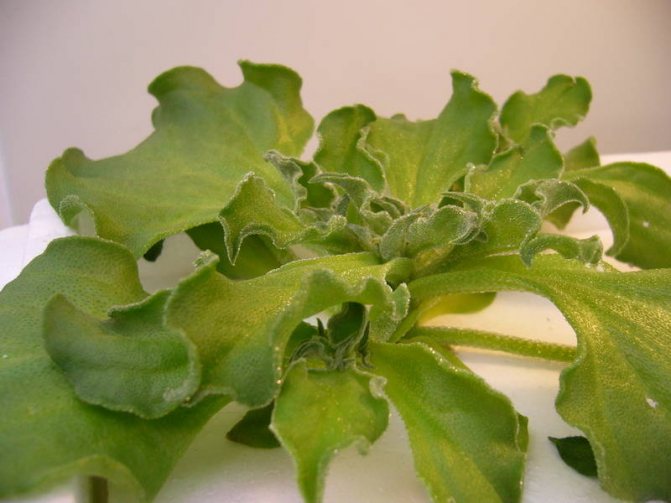

In China, young crystal grass leaves are served with vinegar sauce as a snack at the start of a meal. When this dish is brought, it seems that leaves covered with thick frosty frost are served on a plate, as if they were brought from the freezer, although in reality the dish is at room temperature. The taste is unusually fresh and clean, with a slight hint of sourness and slightly salty. Thousands of small bubbles on the surface of each leaf explode on your tongue as you chew them, creating a flavor spike and the sensation of a fantastic vitamin-enriched drink.
Crystal weed is eaten raw, in salads, or cooked like spinach. It is a great addition to seafood dishes. But, perhaps, best of all, its crystal taste can be felt if it is simply eaten with a shish kebab or other fried meat. Crystal grass in salads goes well with cucumber grass (borago).
1. Seven Secrets of Success:
| 1. Growing temperature: during the period of active growth, the mesembriantemum should be kept at a temperature of 18 to 25 ° C. In the fall, the temperature is lowered and the plant should spend the winter months in a cold room with a temperature of 14 to 16 ° C. |
| 2. Lighting: shading is possible on the hottest days, the rest of the time the direct rays of the sun can fall on the plants. Well lit location with plenty of reflected sunlight. |
| 3. Watering and humidity: dry the soil between waterings by 4 - 5 centimeters in depth, significantly reduce watering in the autumn-winter period. There is no need to increase the air humidity. |
| 4. Features of the: The flower is easy to grow at home with minimal maintenance and still looks very attractive. |
| 5. Priming: the flower is very undemanding to the composition of the soil, but will not grow in a poorly drained substrate. Better applies to nutrient-poor soils. |
| 6. Top dressing: liquid mineral fertilizers for succulent plants and cacti every month in spring and summer. In autumn and winter, the flower is not fed. |
| 7. Reproduction: Mesembriantemum propagates by seed or stem cuttings. |
Botanical name: Mesembryanthemum.
Mesembriantemum flower - family... Aizovs.
Origin... South Africa.
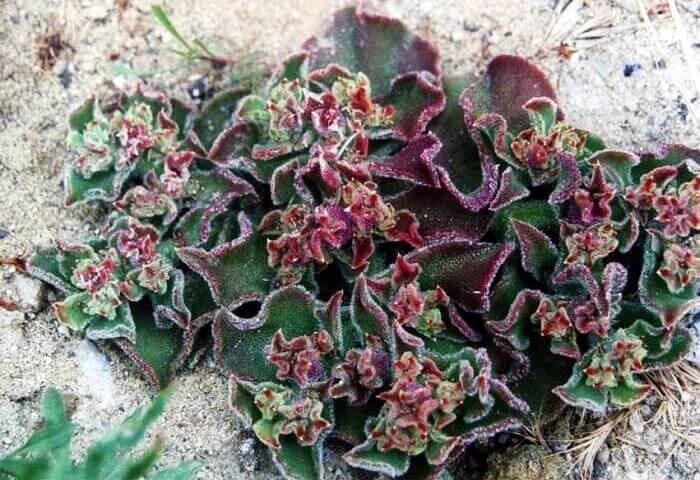

What does it look like. Mesembriantemum - perennial or annual low-growing herb. The stems are lodging, lignify with age, the leaves are juicy, thick, bright green. The size and shape of the leaves is variable and in different species the leaves can be either linear or oblong - oval or even heart-shaped. Young stems, buds and leaves are covered with special glands and it seems as if dew has frozen on them. The flowers are axillary, solitary, very bright, with numerous long petals; they open only on hot, sunny days. Remain half-closed in cloudy weather. Shades of colors range from white, red, pink to yellow. The flowers cover the mesembriantemum very abundantly and often completely hide the foliage.
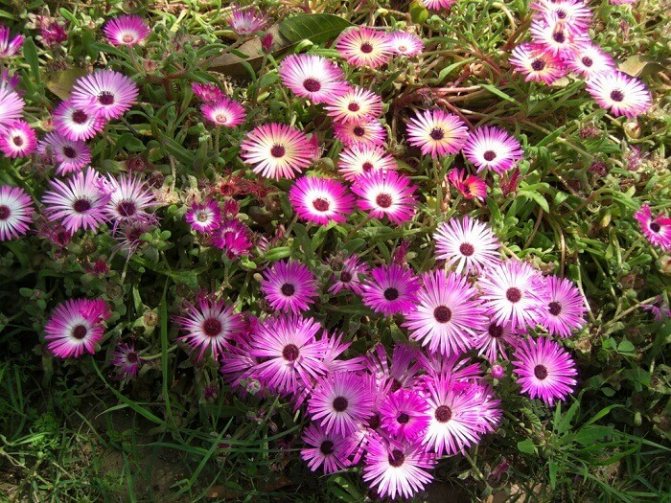

Height... Depends on the species and can be from 4 to 60 cm.
Description
This attractive plant has a second name, dorotheanthus, and flower growers call it the midday flower and crystal chamomile. It belongs to the Aizov family. In stores you can find varieties of annual and perennial, with different shapes of flowers and different colors. Photo of mesembryanthemum:
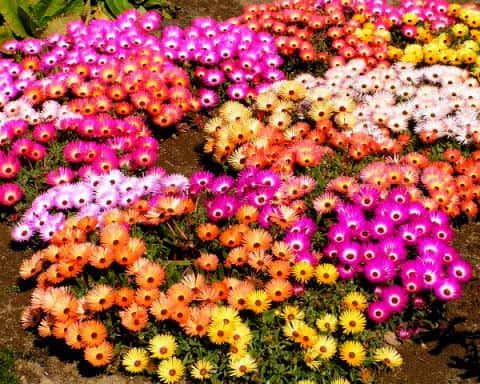

The inflorescences of the mesembryanthemum are similar to chamomile, only in other bright colors. Its flowers open at noon in sunny weather and close in the evening. Their diameter is approximately 8 cm. There are many flowers on one plant.
The foliage and stems of the plant can grow up to 15 cm. The leaves have the shape of a spindle or a shovel, they have a swamp hue.There is no chlorophyll in them, so the main task of the leaves is to supply water. That is why the plant belongs to succulents. The lower leaves grow oppositely, and the upper ones alternately.
Dorotheanthus is planted as a curb or carpet plant. It can be placed on balconies or elevations.
The fruits of the plant are boxes. They contain very small seeds. 1 gram is about 3,000 seeds.
South Africa is considered the homeland of the plant, although they are also found in Peru, New Zealand, Chile and Australia. From this, the conclusion suggests itself that the plant is sun-loving and it is better to plant it on the sunny southern side of the garden.
Where and how it is applied
In the African homeland, plants grow it as a food crop. Delicate leaves have a pleasant sourness. Stewed with butter, they look like spinach.
In the beauty industry, mesembriantemum is used to make anti-wrinkle creams and serums. The active substances penetrate deep into the skin and act at the cellular level.
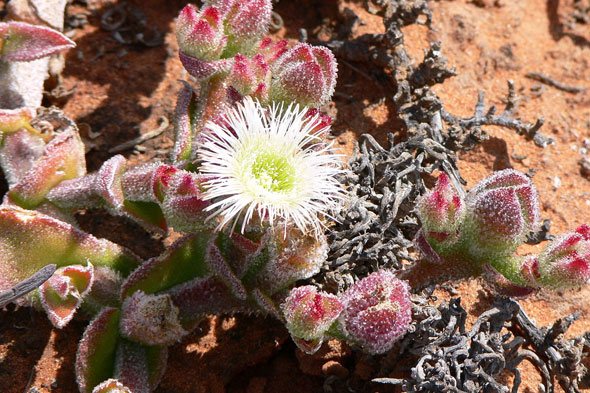

In decorative gardening, it is planted on alpine hills, rockeries, and it is irreplaceable in carpet flower beds. Place the mesembriantemum along the paths and walls of buildings. Crystal grass looks good with small bulbs, as well as bells, lilies, stonecrops.
He looks smart, planted in groups in flowerpots or pots. Bright large flowers with sparkling leaves will add colors to the garden and cheer up its inhabitants.
Tags: alpine hilldecorativeannual plantsoilcoverseedling
Crystal herb is a refreshing vegetable
Crystal Grass is a fast-growing, creeping plant that is commonly found in its natural habitat on the dry land of South Africa and along most of the coast of the Canary Islands. In hot, dry conditions, crystal grass has a pink or rose-red color, which in itself makes it a very attractive plant. Thickets of this plant often cover large areas of the earth with an amazing lively red carpet.
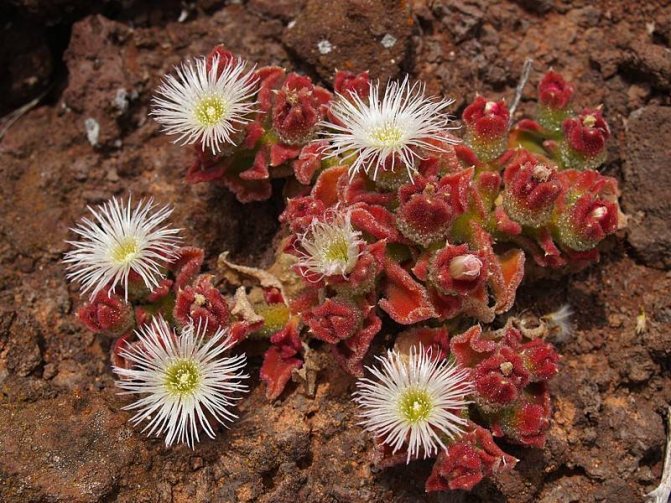

Few people know that most of the most beautiful and famous landscape photographs and art canvases of the Canary Islands, and especially Tenerife, captured this amazing plant in collaboration with bizarre rocks, sands and the sea. Crystal grass is not native to these islands, it was brought there and cultivated in the early 19th century for the production of soda and soap. And then she just stayed there.
The flowers of this plant are also very beautiful. They look a bit like large daisies, usually creamy white in color. When their cups are fully open, they contrast beautifully with the reddish or green foliage around them, which also sparkles in the sun with tiny crystals.
After flowering, the crystal herb forms polyspermous fruits, which are actually edible, and in previous centuries were used for food during periods of food shortages, like the leaves of this plant. The crystal grass turns brown at the end of flowering and dries up, but the thousands of seeds in its fruits resurrect the plant when the rains return to the ground.
Today, this plant also grows in wastelands and abandoned agricultural lands, but more often it can still be found near the sea shores and even right on the sandy peaks of the beaches.
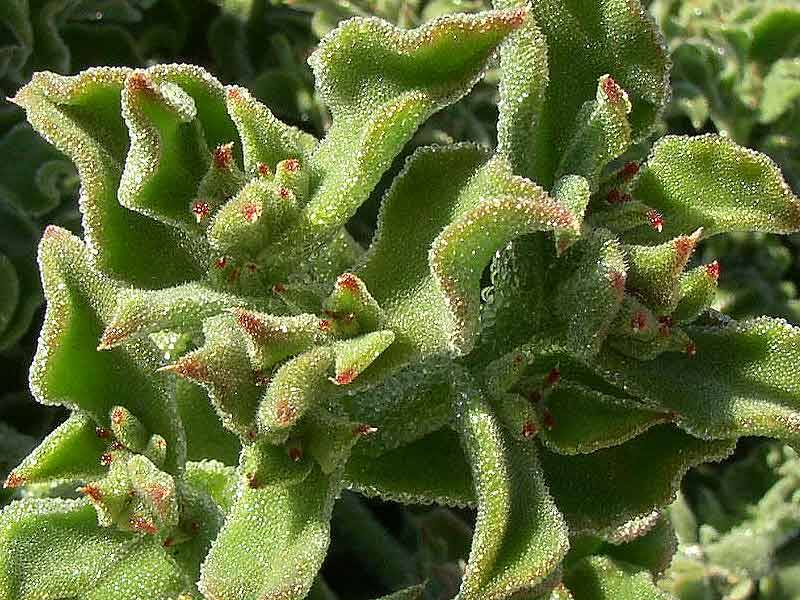

Where does the mesembriantemum grow?
The growth of a flower in its natural environment is due to the presence of a warm temperate climate. The plant is thermophilic, which is why its homeland is South America and Africa.
In artificial habitat, sunflower can be found in temperate and hot climates of Europe and Asia. Midday grows in the Caucasus, the Canary Islands, the southern zone of Australia and the Mediterranean.
Mesembriantemum prefers to grow in open areas. To create growing conditions for the sunflower, it is necessary to provide constant sunlight and dry soil.The flower does not tolerate constant moisture, therefore, it is almost impossible to meet a growing sunflower near rivers and reservoirs. Sandstones and sandy loam soils are optimal.
Plant care on the site
The most important point on which the further successful growth of the mesembryanthemum depends is the choice of the landing site. If at the stage of sowing seeds you choose the right place and prepare the soil, then minimal care will be required in the future.
Care rules:
- It is important to monitor the light level at the site of the mesembryanthemum planting. Lack of light can lead to wilting and death for the plant. If there is not enough sunlight, then you definitely need to take care of an additional source of lighting;
- Before the onset of the flowering period, you can add no more than two types of top dressing. Neglecting this rule can lead to the fact that the inflorescences will not form at all;
- The plant needs watering only during the dry season. Mesembryanthemums do not particularly like water, and therefore they need to be watered only during a prolonged drought;
- If the cold suddenly came, then you can cover the culture with a cloth. As soon as the weather returns to normal, you can remove the cover from the bushes. In this way, the flowering of the shrub can also be controlled;
- After the beginning of flowering, you need to fertilize the shrub every 15-25 days. For fertilization, it is best to use special mineral fertilizing;
- The plant does not need to be pruned. Mesembriantemum does not need pruning and bush formation. Flowering continues from late spring to early autumn.
Useful properties of the mesembriantemum plant
African tribes grow mesembriantemum as a vegetable crop. The leaves, stewed with butter, taste like spinach.
The plant is widely used in cosmetology. Specialists of one of the largest cosmetic companies Yves Rocher have isolated an anti-wrinkle extract from mesembriantemum crystallinum. It is unique in that it acts on the skin at the cellular level.
Yves Rocher cultivates it on his own plantations in the French town of La Gasilla, using the beneficial properties of the plant in the production of "serum of life".
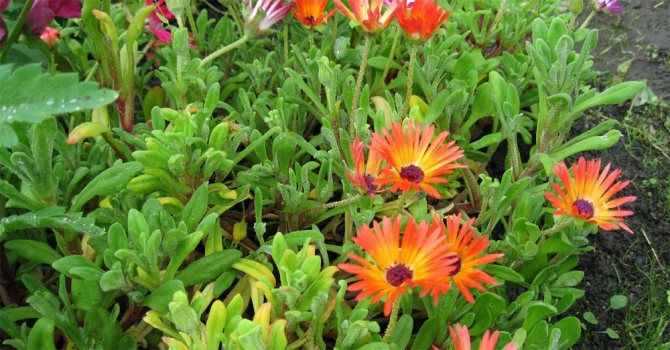

Mesembriantemum is used in cosmetology and cooking.
The miraculous properties of mesembryanthemum allow you to start regenerating processes in the human body and significantly reduce the impact of environmentally harmful factors on the skin.
Important. The miraculous extract cannot be prepared at home by digesting and infusing leaves and flowers. It is obtained on sophisticated equipment using the technology of enzymatic cryoextraction.

